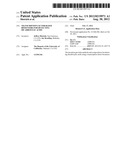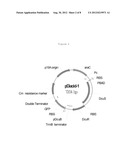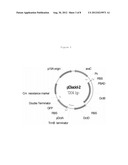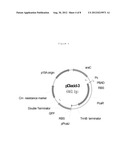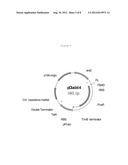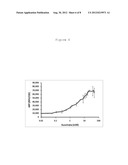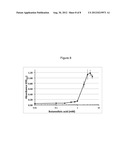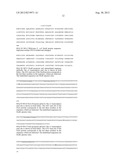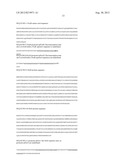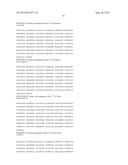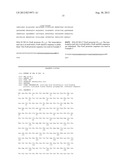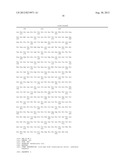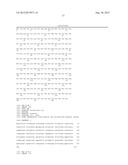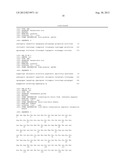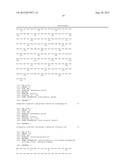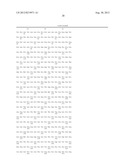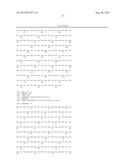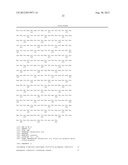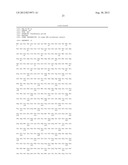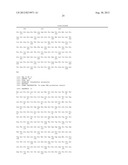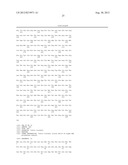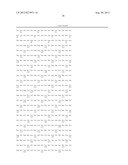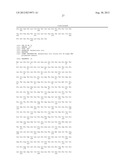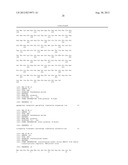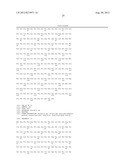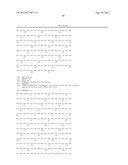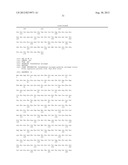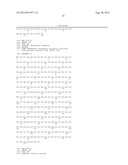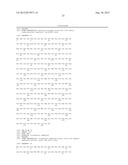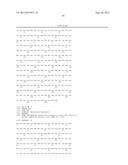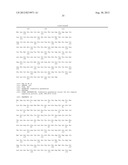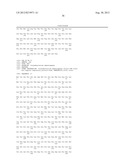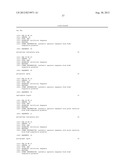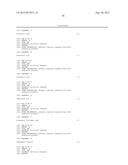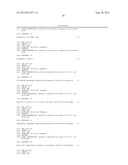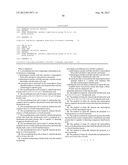Patent application title: TRANSCRIPTION FACTOR-BASED BIOSENSORS FOR DETECTING DICARBOXYLIC ACIDS
Inventors:
Jeffrey Dietrich (San Francisco, CA, US)
Jay Keasling (Berkeley, CA, US)
Assignees:
THE REGENTS OF THE UNIVERSITY OF CALIFORNIA
IPC8 Class: AG01N33566FI
USPC Class:
435 737
Class name: Involving a micro-organism or cell membrane bound antigen or cell membrane bound receptor or cell membrane bound antibody or microbial lysate bacteria or actinomycetales escherichia coli
Publication date: 2012-08-30
Patent application number: 20120219971
Abstract:
The invention provides methods and compositions for detecting
dicarboxylic acids using a transcription factor biosensor.Claims:
1. A recombinant host cell comprising a transcription factor biosensor
comprising: a heterologous nucleic acid that encodes a transcription
factor that can bind to and activate a promoter; a heterologous nucleic
acid that encodes a protein moiety that binds a dicarboxylic acid; and
the promoter that is activated by the transcription factor operably
linked to a nucleic acid sequence that encodes a heterologous reporter
gene.
2. The recombinant host cell of claim 1, wherein the dicarboxylic acid is a C4, C5, C6, or C7 dicarboxylic acid.
3. The recombinant host cell of claim 1, wherein the dicarboxylic acid is a C8, C9, C10, C11, C12, C13, or C14 dicarboxylic acid.
4. The recombinant host cell of claim 1, wherein the transcription factor comprises the protein moiety that binds the dicarboxylic acid.
5. The recombinant host cell of claim 4, wherein the transcription factor is a PcaR transcription factor.
6. The recombinant host cell of claim 5, wherein the promoter is a PcaR promoter or a PcalJ promoter.
7. The recombinant host cell of claim 1, wherein the protein moiety that binds the dicarboxylic acid is comprised by a membrane-associated protein that is capable of detecting exogenous dicarboxylic acid.
8. The recombinant host cell of claim 7, wherein the transcription factor is DcuR and the protein moiety that binds the dicarboxylic acid is a DcuS histidine kinase.
9. The recombinant host cell of claim 8, wherein the promoter is a DctA promoter.
10. The recombinant host cell of claim 1, wherein the host cell is Escherichia coli.
11. A method of detecting a dicarboxylic acid, the method comprising providing a recombinant host cell that comprises: a heterologous nucleic acid that encodes a transcription factor that can bind to and activate a promoter; a heterologous nucleic acid that encodes a protein moiety that binds a dicarboxylic acid; and the promoter that is activated by the transcription factor operably linked to a nucleic acid sequence that encodes a heterologous reporter gene; culturing the host cell under conditions in which the transcription factor and protein moiety that binds a dicarboxylic acid are expressed; and detecting expression of the reporter gene.
12. The method of claim 11, wherein the dicarboxylic acid is a C4, C5, C6, or C7 dicarboxylic acid.
13. The method of claim 11, wherein the dicarboxylic acid is a C8, C9, C10, C11, C12, C13, or C14 dicarboxylic acid.
14. The method of claim 11, wherein the transcription factor comprises the protein moiety that binds the dicarboxylic acid.
15. The method of claim 14, wherein the transcription factor is a PcaR transcription factor.
16. The method of claim 15, wherein the promoter is a PcaR promoter or a PcalJ promoter.
17. The method of claim 11, wherein the moiety that binds the dicarboxylic acid is comprised by a membrane associated protein that is capable of detecting exogenous dicarboxylic acid.
18. The method of claim 17, wherein the transcription factor is DcuR and the moiety that binds the dicarboxylic acid is a DcuS histidine kinase.
19. The method of claim 18, wherein the promoter is a DctA promoter.
20. The method of claim 11, wherein the recombinant host cell is an Escherichia coli cell.
Description:
CROSS-REFERENCE TO RELATED APPLICATIONS
[0001] The application claims benefit of U.S. provisional application No. 61/444,302, filed Feb. 18, 2011, which application is herein incorporated by reference for all purposes.
BACKGROUND OF THE INVENTION
[0003] Dicarboxylic acids (diacids) are important compounds that are used in the manufacture of commercial polymers (e.g. polyesters, polyurethanes). Recently, methods and compositions for generating diacids by engineering microorganisms to produce diacids have been described (see, e.g., WO2009/121066, incorporated by reference).
[0004] The ability to sensitively and rapidly quantify dicarboxylic acid titers from production strains of microorganisms is difficult to accomplish to date. The identification of improved production strains requires variant libraries ranging in size from 102 to 109 to be constructed and screened in an experiment; in general, the larger the library size screened the higher the probability of identifying improved production variants. Screening by liquid chromatography-mass spectrometry, which is the gold-standard in dicarboxylic acid quantification, suffers from low-throughputs and only 102-103 samples can be reasonably analyzed per experiment. Intramolecular excimer-forming fluorescence derivatization was recently demonstrated for detection of dicarboxylic acids in urine samples; the method offers improved throughputs (˜104-105 variants per experiment), but requires extraction with organic solvents, multiple liquid handling steps, and derivatization of the diacid substrate for detection. The above factors impart significant costs that prohibit large-scale implementation of this screening setup. There thus remains need for a low-cost, high-throughput, accurate, and sensitive dicarboxylic acid screening assay. This invention addressed this need.
BRIEF SUMMARY OF THE INVENTION
[0005] The present invention is based, in part, on the discovery that a biosensor-based system can be used for the accurate detection of exogenous dicarboxylic acids in liquid or solid media and in vivo detection of endogenously produced diacids within a host. Microorganisms are highly adept at sensing and responding to small-molecules in their environment. For example, transcription factors that bind dicarboxylic acids can modulate expression of one or more reporter genes downstream of the transcription factor's cognate promoter. By monitoring the expression of the reporter genes dicarboxylic acid concentration can be readily measured.
[0006] Thus, in some embodiments, the invention provides a recombinant host cell comprising a transcription factor biosensor comprising: a transcription factor that can bind to and activate a promoter; a protein moiety that binds a dicarboxylic acid; and a promoter that is activated by the transcription factor, where the promoter is operably linked to a nucleic acid sequence that encodes a heterologous reporter gene. In some embodiments, the recombinant host cell comprises a heterologous nucleic acid encoding the transcription factor and/or a heterologous nucleic acid that encodes the moiety that binds the dicarboxylic acid, and/or a nucleic acid comprising a heterologous promoter operably linked to the reporter gene. In some embodiments, an endogenous transcription factor gene corresponding to the transcription factor sensor gene and/or an endogenous promoter sequence that the transcription factor binds to are inactivated in the recombinant host cell. The dicarboxylic acid to which the dicarboxylic binding moiety binds may be a C4, C5, C6, or C7 dicarboxylic acid. In some embodiments, the dicarboxylic acid is a C8, C9, C10, C11, C12, C13, or C14 dicarboxylic acid. In some embodiments, the dicarboxylic acid has a backbone comprising an even number of carbon atoms. In other embodiments, the dicarboxylic acid has a backbone comprising an odd number of carbon atoms.
[0007] In some embodiments of the invention, the transcription factor itself comprises the protein moiety that binds the dicarboxylic acid, e.g., the transcription factor may be a PcaR transcription factor. In some embodiments, the promoter that is operably linked to a reporter gene to which a PcaR polypeptides binds is a PcaR promoter or a Pun promoter. In some embodiments, the host cell further comprises a nucleic acid sequence encoding a dicarboxylic acid transporter to transport, e.g., uptake, exogenous dicarboxylic acid.
[0008] In some embodiments of a dicarboxylic acid biosensor system of the invention, the polypeptide moiety that binds the dicarboxylic acid is membrane associated sensory protein, e.g., a histidine kinase sensory protein, that is capable of binding to and detecting exogenous dicarboxylic acid. In some embodiments, the transcription factor is DcuR and the protein moiety that binds the dicarboxylic acid is a DcuS histidine kinase. In some embodiments where the transcription factor/sensor is a DcuR-DcuS, the promoter operably linked to a reporter gene may be, e.g., a DcuB promoter, a DctA promoter or a FrdA promoter. In some embodiments, the transcription factor is a DctD transcription factor and the moiety that binds the dicarboxylic acid is a DctB histidine kinase and the promoter linked to the reporter gene is, e.g., a DctA promoter. In some embodiments, e.g., where a DctD-DctB transcription factor/sensor is employed, a recombinant host further comprises a nucleic acid encoding a heterologous σ 54-RNA polymerase.
[0009] A recombinant host cell comprising a dicarboxylic acid biosensor system of the invention may be any kind of prokaryotic cell, e.g., in some embodiments, the recombinant host cell is Escherichia coli.
[0010] In a further aspect, the invention provides a method of detecting a dicarboxylic acid, the method comprising providing a recombinant host cell that comprises a dicarboxylic acid biosensor described herein and detecting expression of the reporter gene. In some embodiments, the method detects the presence of dicarboxylic acid that is produced by the host cell. In some embodiments, the host cell is contacted with a mixture, e.g., cell culture media, that is being analyzed for the presence of one or more dicarboxylic acids.
[0011] The invention further provides a mixture capable of transcribing RNA, the mixture comprising a transcription factor biosensor comprising components as described herein: a transcription factor that can bind to and activate a promoter; a protein moiety that binds a dicarboxylic acid; and the promoter that is activated by the transcription factor operably linked to a nucleic acid sequence that encodes a heterologous reporter gene. The protein moiety that binds the dicarboxylic acid may be part of the transcription factor, e.g., a PcaR transcription factor; or present on a separate polypeptide, e.g., a DcuS polypeptide in a DcuS-DcuR system; or a DctD-DctB system. In some embodiments, the mixture further comprises at least one dicarboxylic acid.
BRIEF DESCRIPTION OF THE DRAWINGS
[0012] FIG. 1 provides an alignment of PcaR transcription factor amino acid sequences. A multiple sequence alignment of PcaR with ten representative protein sequences from the NCBI database, redundant sequences from different strains of the same species were excluded from the alignment. Each of the sequences is named by its gene ID; the sequence designated as "PcaR" is the reference sequence SEQ ID NO:6. SEQ ID NO:6 exhibits between 49% and 88% identity to the sequences shown in this alignment.
[0013] FIG. 2 provides a map of an illustrative plasmid of the invention, which encodesa dicarboxylic acid biosensor of the invention, that comprising nucleic acid sequences encoding DcuR and DcuS and a green fluorescent protein operably linked to a DcuB promoter.
[0014] FIG. 3 provides a map of an illustrative plasmid of the invention, which encodes a dicarboxylic acid biosensor of the invention, where the plasmid is analogous to the plasmid shown in FIG. 2 in which the Sinorhizobium meliloti genes encoding for DctB and DctD replace the DcuR and DcuS genes; and a DctA promoter replaces the DcuB promoter.
[0015] FIG. 4 provides a map of an illustrative plasmid of the invention, which encodes a dicarboxylic acid biosensor of the invention, that comprises nucleic acid sequences a PcaR transcription factor and a green fluorescent protein reporter gene operably linked to a PcalJ promoter.
[0016] FIG. 5 provides a map of an illustrative plasmid of the invention comprising a tetA gene encoding the tetracycline resistance conferring protein TetA. In this example, the tetA gene replaces the GFP reporter gene in plasmid pDiacid-3 (FIG. 4), forming plasmid pDiacid-4.
[0017] FIG. 6 shows an idealized dose-response curve for a DcuS-DcuR transcription factor dicarboxylic acid biosensor.
[0018] FIG. 7 shows dose-response curves for a P. putida PcaR transcription factor-based dicarboxylic acid biosensor of the invention. The X-axis is the concentration of exogenous dicarboxylic acid supplemented to the growth medium; the Y-axis is the cell culture density (OD600) after 12 hours growth in medium supplemented with 25 μg/ml tetracycline. E. coli strain "PcaR (+)" comprises plasmids S3/S2 and produces the tetracycline resistance protein upon exogenous addition of dicarboxylic acids. E. coli strain "PcaR (-)" comprises plasmids S1/S2 and produces a negative control protein, PcaI, upon exogenous addition of the indicated dicarboxylic acids. The PcaR biosensor displayed dicarboxylic acid-dependent increases in tetracycline resistance as measured by the increase in OD600 with the increase in concentration of exogenously added butanedioic acid (Panel A), pentanedioic acid (Panel B), hexanedioic acid (Panel C), and heptanedioic acid (Panel D).
[0019] FIG. 8 shows a dose-response curve for an E. coli DcuS-DcuR two-component system based dicarboxylic acid biosensor of the invention using promoter PDctA. The X-axis is the concentration of exogenous dicarboxylic acid supplemented to the growth medium; the Y-axis is the cell culture density (OD600) after 12 hours growth in medium supplemented with 25 μg/ml tetracycline. The E. coli strain "DctA" comprises plasmid S4 and produces the tetracycline resistance protein upon exogenous addition of butanedioic acid. The DctA biosensor displayed butanedioic acid-dependent increases in tetracycline resistance as measured by the increase in OD600 with the increase in concentration of exogenously added dicarboxylic acid.
DETAILED DESCRIPTION OF THE INVENTION
I. Definitions
[0020] The term "transcription factor biosensor" as used herein refers to a system to detect a dicarboxylic acid by activating expression of a reporter gene where reporter gene expression is mediated by a transcription factor that is capable of binding to a promoter and activating transcription upon binding of a dicarboxylic acid to a sensory protein that induces a change in transcription factor conformation from an inactive to an active form, or upon binding of a dicarboxylic acid to the transcription factor itself. For example, in an embodiment employing a sensory protein, a dicarboxylic acid may bind to a transmembrane receptor (e.g., DcuS) that upon binding the dicarboxylic acid, phosphorylates a transcription factor (e.g., DcuR); phosphorylated DcuR is active and promotes transcription from its cognate promoter (e.g. P.sub.DcuB). A "transcription factor biosensor" of the invention thus comprises a transcription factor that has a DNA binding domain and an activation domain such that the transcription factor is capable of binding to and activating a promoter; a protein moiety that binds a dicarboxylic acid; and a reporter gene expressed from a coding sequence operably linked to a promoter that is activated by the transcription factor. The protein moiety that binds to the dicarboxylic acid may be part of the transcription factor or may be present in a different protein, e.g., a transmembrane protein in which the dicarboxylic acid binding moiety can bind to exogenous dicarboxylic acids.
[0021] As used herein, the term "transcription factor that is activated by dicarboxylic acid" refers to a transcription factor that binds to a dicarboxylic acid or that responds to a signal generated from a protein that binds the dicarboxylic acid.
[0022] The term "downstream target," when used in the context of a downstream target of a transcription factor that activates a promoter refers to a gene or protein whose expression is directly or indirectly regulated by the transcription factor.
[0023] The term "activation of a promoter" refers to inducing expression of a gene that is operably linked to the promoter. In the context of this invention, a promoter is activated either when a transcription factor that is part of a transcription factor biosensor system of the invention binds to the promoter such that gene expression can be initiated, or when a transcription factor that is part of a transcription factor biosensor system of the invention binds to the target ligand and the promoter is derepressed. Activation can be determined relative to the level of gene expression when the transcription factor is not bound to the target ligand. Alternatively, activation is determined relative to the level of gene expression when the target ligand is not present or is present at some designated level or concentration.
[0024] In the context of the current invention, a host cell "capable of expressing" a reporter gene when a transcription factor biosensor of the invention binds to a promoter coupled to the reporter gene in response to the presence of a dicarboxylic acid in the environment, refers to a host cell that has an RNA polymerase that is responsive to the promoter and the transcription factor such that transcription of the reporter gene can be initiated. In the current context, "activation" of an RNA polymerase by a transcription factor refers to activation by interaction of the transcription factor with the polymerase, as well as to activation that is mediated by the promoter, i.e., where binding of the transcription factor to the promoter enables the RNA polymerase to better bind to the promoter and transcribe the gene.
[0025] A "mixture capable of transcribing RNA" in the context of this invention refers to a mixture that has all of the necessary components for transcription of a reporter gene, including but not limited to, a polymerase that is capable of being activated by the transcription factor upon binding of the transcription factor to a promoter, and any necessary cofactors and nucleotide triphosphates.
[0026] The terms "polynucleotide" and "nucleic acid" are used interchangeably and refer to a single or double-stranded polymer of deoxyribonucleotide or ribonucleotide bases. A nucleic acid of the present invention will generally contain phosphodiester bonds, although in some cases, nucleic acid analogs may be used that may have alternate backbones, comprising, e.g., phosphoramidate, phosphorothioate, phosphorodithioate, or O-methylphosphoroamidite linkages (see Eckstein, Oligonucleotides and Analogues: A Practical Approach, Oxford University Press); positive backbones; non-ionic backbones, and non-ribose backbones. Thus, nucleic acids or polynucleotides may also include modified nucleotides that permit correct read-through by a polymerase. "Polynucleotide sequence" or "nucleic acid sequence" refers to the order of the bases in a polynucleotide or nucleic acid and includes both the sense and antisense strands of a nucleic acid as either individual single strands or in a duplex. As will be appreciated by those in the art, the depiction of a single strand also defines the sequence of the complementary strand; thus the sequences described herein also provide the complement of the sequence. Unless otherwise indicated, a particular nucleic acid sequence also implicitly encompasses variants thereof (e.g., degenerate codon substitutions) and complementary sequences, as well as the sequence explicitly indicated. The nucleic acid may be DNA, both genomic and cDNA, RNA or a DNA/RNA hybrid, where the nucleic acid may contain combinations of deoxyribo- and ribo-nucleotides, and combinations of bases, including uracil, adenine, thymine, cytosine, guanine, inosine, xanthine hypoxanthine, isocytosine, isoguanine, etc.
[0027] The term "substantially identical," used in the context of two nucleic acids or polypeptides, refers to a sequence that has at least 60% sequence identity with a reference sequence. Percent identity can be any integer from 60% to 100%. Some embodiments include at least: 60%, 65%, 70%, 75%, 80%, 85%, 90%, 91%, 92%, 93%, 94%, 95%, 96%, 97%, 98%, or 99% identity, over a region of at least 25 or 50 contiguous residues, typically at least 100, 200, 300, 400 or more contiguous residues, or over the full length, to a reference sequence compared using the programs described herein; preferably BLAST using standard parameters, as described below. In some embodiments, the percent identity is determined over the entire length of the reference sequence. For example, a polypeptide that is part of a transcription factor biosensor of the invention may have an amino acid sequence that is at least 60%, 65%, 70%, 75%, 80%, 85%, 90%, 91%, 92%, 93%, 94%, 95%, 96%, 97%, 98%, or 99% identical to a reference sequence of SEQ ID NO:1, SEQ ID NO:2, SEQ ID NO:6, SEQ ID NO:9, SEQ ID or SEQ ID NO:10 across the full-length of the reference sequence.
[0028] Two nucleic acid sequences or polypeptide sequences are said to be "identical" if the sequence of nucleotides or amino acid residues, respectively, in the two sequences is the same when aligned for maximum correspondence as described below. The terms "identical" or percent "identity," in the context of two or more nucleic acids or polypeptide sequences, refer to two or more sequences or subsequences that are the same or have a specified percentage of amino acid residues or nucleotides that are the same, when compared and aligned for maximum correspondence over a comparison window, as measured using one of the following sequence comparison algorithms or by manual alignment and visual inspection. When percentage of sequence identity is used in reference to proteins or peptides, it is recognized that residue positions that are not identical often differ by conservative amino acid substitutions, where amino acids residues are substituted for other amino acid residues with similar chemical properties (e.g., charge or hydrophobicity) and therefore do not change the functional properties of the molecule. Where sequences differ in conservative substitutions, the percent sequence identity may be adjusted upwards to correct for the conservative nature of the substitution. Means for making this adjustment are well known to those of skill in the art. Typically this involves scoring a conservative substitution as a partial rather than a full mismatch, thereby increasing the percentage sequence identity. Thus, for example, where an identical amino acid is given a score of 1 and a non-conservative substitution is given a score of zero, a conservative substitution is given a score between zero and 1. The scoring of conservative substitutions is calculated according to, e.g., the algorithm of Meyers & Miller, Computer Applic. Biol. Sci. 4:11-17 (1988).
[0029] For sequence comparison, typically one sequence acts as a reference sequence, to which test sequences are compared. When using a sequence comparison algorithm, test and reference sequences are entered into a computer, subsequence coordinates are designated, if necessary, and sequence algorithm program parameters are designated. Default program parameters can be used, or alternative parameters can be designated. The sequence comparison algorithm then calculates the percent sequence identities for the test sequences relative to the reference sequence, based on the program parameters. Alternatively, sequences may be manually aligned for comparison.
[0030] A "comparison window," as used herein, includes reference to a segment of any one of a number of contiguous positions, typically from about 20 to about 600 contiguous positions, usually about 50 to about 200 contiguous positions, or about 100 to about 150 contiguous positions, in which a sequence may be compared to a reference sequence of the same number of contiguous positions after the two sequences are optimally aligned. In some embodiments, comparison are over the length of the two sequences being compared. Methods of alignment of sequences for comparison are well-known in the art. Optimal alignment of sequences for comparison can be conducted, e.g., by the local homology algorithm of Smith & Waterman, Adv. Appl. Math. 2:482 (1981), by the homology alignment algorithm of Needleman & Wunsch, J. Mol. Biol. 48:443 (1970), by the search for similarity method of Pearson & Lipman, Proc. Nat'l. Acad. Sci. USA 85:2444 (1988), by computerized implementations of these algorithms (GAP, BESTFIT, FASTA, and TFASTA in the Wisconsin Genetics Software Package, Genetics Computer Group, 575 Science Dr., Madison, Wis.), or by manual alignment and visual inspection.
[0031] Algorithms that are suitable for determining percent sequence identity and sequence similarity are the BLAST and BLAST 2.0 algorithms, which are described in Altschul et al. (1990) J. Mol. Biol. 215: 403-410 and Altschul et al. (1977) Nucleic Acids Res. 25: 3389-3402, respectively. Software for performing BLAST analyses is publicly available through the National Center for Biotechnology Information (NCBI) web site. The algorithm involves first identifying high scoring sequence pairs (HSPs) by identifying short words of length W in the query sequence, which either match or satisfy some positive-valued threshold score T when aligned with a word of the same length in a database sequence. T is referred to as the neighborhood word score threshold (Altschul et al, supra). These initial neighborhood word hits acts as seeds for initiating searches to find longer HSPs containing them. The word hits are then extended in both directions along each sequence for as far as the cumulative alignment score can be increased. Cumulative scores are calculated using, for nucleotide sequences, the parameters M (reward score for a pair of matching residues; always >0) and N (penalty score for mismatching residues; always <0). For amino acid sequences, a scoring matrix is used to calculate the cumulative score. Extension of the word hits in each direction are halted when: the cumulative alignment score falls off by the quantity X from its maximum achieved value; the cumulative score goes to zero or below, due to the accumulation of one or more negative-scoring residue alignments; or the end of either sequence is reached. The BLAST algorithm parameters W, T, and X determine the sensitivity and speed of the alignment. The BLASTN program (for nucleotide sequences) uses as defaults a word size (W) of 28, an expectation (E) of 10, M=1, N=-2, and a comparison of both strands. For amino acid sequences, the BLASTP program uses as defaults a word size (W) of 3, an expectation (E) of 10, and the BLOSUM62 scoring matrix (see Henikoff & Henikoff, Proc. Natl. Acad. Sci. USA 89:10915 (1989)).
[0032] The BLAST algorithm also performs a statistical analysis of the similarity between two sequences (see, e.g., Karlin & Altschul, Proc. Nat'l. Acad. Sci. USA 90:5873-5787 (1993)). One measure of similarity provided by the BLAST algorithm is the smallest sum probability (P(N)), which provides an indication of the probability by which a match between two nucleotide or amino acid sequences would occur by chance. For example, a nucleic acid is considered similar to a reference sequence if the smallest sum probability in a comparison of the test nucleic acid to the reference nucleic acid is less than about 0.01, more preferably less than about 10-5, and most preferably less than about 10-20.
[0033] Nucleic acid or protein sequences that are substantially identical to a reference sequence include "conservatively modified variants." With respect to particular nucleic acid sequences, conservatively modified variants refers to those nucleic acids which encode identical or essentially identical amino acid sequences, or where the nucleic acid does not encode an amino acid sequence, to essentially identical sequences. Because of the degeneracy of the genetic code, a large number of functionally identical nucleic acids encode any given protein. For instance, the codons GCA, GCC, GCG and GCU all encode the amino acid alanine. Thus, at every position where an alanine is specified by a codon, the codon can be altered to any of the corresponding codons described without altering the encoded polypeptide. Such nucleic acid variations are "silent variations," which are one species of conservatively modified variations. Every nucleic acid sequence herein which encodes a polypeptide also describes every possible silent variation of the nucleic acid. One of skill will recognize that each codon in a nucleic acid (except AUG, which is ordinarily the only codon for methionine) can be modified to yield a functionally identical molecule. Accordingly, each silent variation of a nucleic acid which encodes a polypeptide is implicit in each described sequence.
[0034] As to amino acid sequences, one of skill will recognize that individual substitutions, in a nucleic acid, peptide, polypeptide, or protein sequence which alters a single amino acid or a small percentage of amino acids in the encoded sequence is a "conservatively modified variant" where the alteration results in the substitution of an amino acid with a chemically similar amino acid. Conservative substitution tables providing functionally similar amino acids are well known in the art.
[0035] The following six groups provides examples of conservative substitutions. Each group contains amino acids that are conservative substitutions for one another:
1) Alanine (A), Serine (S), Threonine (T);
[0036] 2) Aspartic acid (D), Glutamic acid (E);
3) Asparagine (N), Glutamine (Q);
4) Arginine (R), Lysine (K);
5) Isoleucine (I), Leucine (L), Methionine (M), Valine (V); and
6) Phenylalanine (F), Tyrosine (Y), Tryptophan (W).
[0037] (see, e.g., Creighton, Proteins (1984)).
[0038] Another indication that nucleotide sequences are substantially identical is if two molecules hybridize to each other, or a third nucleic acid, under stringent conditions. Stringent conditions are sequence dependent and will be different in different circumstances. Generally, stringent conditions are selected to be about 5° C. lower than the thermal melting point (Tm) for the specific sequence at a defined ionic strength and pH. The Tm is the temperature (under defined ionic strength and pH) at which 50% of the target sequence hybridizes to a perfectly matched probe. Typically, stringent conditions will be those in which the salt concentration is about 0.02 molar at pH 7 and the temperature is at least about 60° C. For example, stringent conditions for hybridization, such as RNA-DNA hybridizations in a blotting technique are those which include at least one wash in 0.2×SSC at 55° C. for 20 minutes, or equivalent conditions.
[0039] The term "promoter," as used herein, refers to a polynucleotide sequence capable of driving transcription of a DNA sequence, which may be referred to herein as a "coding sequence", in a cell. The promoter comprises cis-acting regions that typically interact with proteins or other biomolecules to carry out (turn on/off, regulate, modulate, etc.) gene transcription. Promoters are located 5' to the transcribed gene, and as used herein, include the sequence 5' from the translation start codon. By convention, the promoter sequence is usually provided as the sequence on the coding strand of the gene it controls. A "gene" may thus typically include at least a promoter and a coding sequence.
[0040] A polynucleotide is "heterologous" to an organism or a second polynucleotide sequence if it originates from a foreign species, or, if from the same species, is modified from its original (native or naturally occurring) form. For example, when a polynucleotide encoding a polypeptide sequence is said to be operably linked to a heterologous promoter, it means that the polynucleotide coding sequence encoding the polypeptide is derived from one species whereas the promoter sequence is derived from another, different species; or, if both are derived from the same species, the coding sequence is not naturally associated with the promoter (e.g., is a genetically engineered coding sequence, e.g., from a different gene in the same species, or an allele from a different ecotype or variety).
[0041] The term "operably linked" refers to a functional relationship between two or more polynucleotide (e.g., DNA) segments. Typically, it refers to the functional relationship of a transcriptional regulatory sequence to a transcribed sequence. For example, a promoter or enhancer sequence is operably linked to a DNA sequence if it stimulates or modulates the transcription of the DNA sequence in an appropriate host cell or other expression system. In typical embodiments of the invention, promoter transcriptional regulatory sequences in the context of this invention, that are operably linked to a transcribed sequence are physically contiguous to the transcribed sequence, i.e., they are cis-acting.
[0042] The term "expression cassette" refers to a nucleic acid construct that, when introduced into a host cell, results in transcription and/or translation of an RNA or polypeptide, respectively. Constructs that are not or cannot be translated, e.g., particular promoter sequences that may be contained with an expression cassette, are expressly included by this definition.
[0043] The singular forms "a", "and", and "the" include plural referents unless the context clearly dictates otherwise. Thus, for example, reference to "a carboxylic acid" includes a plurality of such carboxylic acids, and so forth.
II. Introduction
[0044] The present invention is based, in part, on the discovery that a transcription-based biosensor system can be used for the accurate detection of exogenous dicarboxylic acids in liquid or solid media and in vivo detection of endogenously produced diacids within a host. Thus, the invention provides methods and compositions for identifying microorganisms that produce a dicarboxylic acid and/or produce the dicarboxylic acid at a desired level. In the current invention, a dicarboxylic acid binds to a protein moiety that is either present on a transcription factor itself or is part of a second protein that transduces a signal to the transcription factor. Binding of the dicarboxylic acid to the dicarboxylic acid binding moiety results in either binding of the transcription factor to the promoter that is activated by the transcription factor, or in some embodiments, results in derepression of the promoter by the dicarboxylic acid-bound transcription factor.
[0045] In some embodiments, the system is an in vitro system wherein all of the necessary components for transcription of the reporter gene, including but not limited to a polymerase that is capable of being activated by the transcription factor upon binding of the transcription factor to a promoter, and any necessary cofactors and nucleotide triphosphates, are present in the system. Accordingly, in some embodiments, the invention provides a mixture comprising a transcription factor biosensor of the invention, a promoter operably linked to a reporter gene where the promoter is a promoter that binds the transcription factor that is activated by the presence of a dicarboxylic acid, a polymerase, additional reagents, and in some embodiments, a dicarboxylic acid.
[0046] In some embodiments, the system is an in vivo system wherein all of the necessary components for transcription of the reporter gene are present within a host cell.
Transcription Factors-Promoters for Use in the Invention
[0047] Any number of transcription factors that bind to dicarboxylic acid, or are activated to bind to a promoter in response to a signal generated by binding of a dicarboxylic acid to a binding moiety, are suitable for use in the invention.
[0048] In some embodiments, the transcription factor can bind a dicarboxylic acid, which results in binding of the transcription factor to a cognate promoter and activation of a gene that is operably linked to the promoter. Transcription factors that bind dicarboxylic acids include the transcription factor PcaR and homologs, see, e.g., FIG. 1.
[0049] In one embodiment, a transcription factor used in the invention is a PcaR transcription factor. A PcaR transcription factor can directly bind a dicarboxylic substrate and regulate transcription mediated by promoters such as the P.sub.PcaR and P.sub.PcaIJ promoters. Thus, in such embodiments, the dicarboxylic binding moiety is contained within the transcription factor itself and no additional sensory polypeptides are required for function. PcaR binds C6 dicarboxylic acids (beta-keto hexanedioic acid and hexanedioic acid) substrates. PcaR and PcaR-responsive promoters are known in the art (see, e.g., Guo Z, et al. "PcaR-mediated activation and repression of pca genes from Pseudomonas putida are propagated by its binding to both the -35 and the -10 promoter elements." Mol. Microbiol. 32(2):253-63 (1999), incorporated by reference).
[0050] An example of a PcaR polypeptide sequence from Pseudomonas putida is provided in SEQ ID NO:6. PcaR polypeptides that can be employed also include variants and homologs of the PcaR polypeptide sequence set forth in SEQ ID NO:6. Thus, a PcaR transcription factor polypeptide may have an amino acid sequence that has at least 60% identity, typically at least 70%, 75%, 80%, 85%, 90%, 91%, 92%, 93%, 94%, 95%, 96%, 97%, 98% or 99%, or greater, amino acid sequence identity, preferably over a region of at least 100 or more amino acids, or at least 200 or more amino acids, or over the length of the entire polypeptide, to an amino acid sequence of SEQ ID NO:6. Examples of PcaR amino acid sequences are provided in FIG. 1. One of skill in the art understands in view of this disclosure that variants can also be employed, e.g., using the known sequences as guidance for selecting amino acid substitutions that will not result in loss of function. PcaR transcription factors for use in the invention comprise an IclR helix-turn-helix domain that is important for recognition of the PcaR operator site. PcaR polypeptides also comprise other functional domains, e.g., a region that plays a role in substrate recognition. An example of a helix-turn-helix domain of a PcaR polypetide is indicated in the illustrative sequence SEQ ID NO:6, shown below, by an underline. A recognition domain that maps to the IclR family of transcription regulators is shown in italics:
TABLE-US-00001 MSDETPANESANPESARPAAPALAPPIVASPAKRIQAFTGDPDFMTSLA RGLAVIQAFQERKRHLTIAQISHRTEIPRAAVRRCLHTLIKLGYATTDG RTYSLLPKVLTLGHAYLSSTPLAISAQPYLDRISDQLHEAANMATLEGD DILYIARSATVERLISVDLSVGGRLPAYCTSMGRILLAAMDDTSLREYL DRADLKARTSRTLNDAESLFACIQQVRAQGWCVVDQELEQGLRSIAVPI YDASGQVLAALNVSTHVGRVTRSELEQRFLPILLAASRDLCHQLFG
[0051] In some embodiments, a PcaR transcription factor for use in the invention is naturally present in a host cell. In other embodiments, a host cell is engineered to express a heterologous transcription factor by introducing an expression cassette comprising a nucleic acid sequence encoding the transcription factor into the host cell.
[0052] The PcaR transcription factor can bind to a number of promoters and activate expression of a gene operably linked to the promoter. Examples of PcaR-responsive promoters suitable for use in accordance with the invention are provided in SEQ ID NOs. 7, 8, 16, and 17.
[0053] In some embodiments, a PcaR-responsive promoter for use in the invention, typically comprises one or more of the operator sequences GTTTGTTCGATAATCGCACGAACG, GCTCGCACATCGCAC, and/or AGTTCGATAATCGCAC. Point mutations can be present in these operator sequences, e.g., the biosensors described in Example 5 contain the operator sequences GTTTGTTCGATAATCGCACGAACG and GCTCGCAGATCGCAC (point mutations are indicated in bold type). In some embodiments, the promoter is at least 90% identical to the promoter sequence shown in SEQ ID NO:7, 8, 16, or 17. In some embodiments, the promoter comprises a subsequence of SEQ ID NO:7, 8, 16, or 17 that comprises 25, 30, 25, 40, or 45, or more, contiguous nucleotides of SEQ ID NO:7, SEQ ID NO:8, SEQ ID NO:16, or SEQ ID NO:17.
Two-Component Transcription Factor Dicarboxylic Acid Sensor
[0054] In some embodiments, the transcription factor employed in a dicarboxylic acid sensor of the invention is responsive to a dicarboxylic acid, but does not itself bind a dicarboxylic acid. Instead, a sensing protein binds to the dicarboxylic acid and then modifies the transcription factor so that the transcription factor binds to a cognate promoter and activates expression of a reporter gene. In some embodiments, the dicarboxylic acid binding moiety is a transmembrane polypeptide.
[0055] In one embodiment, a two-component systems comprises a membrane-associated sensor (sensory histidine kinase DcuS) and a cytosolic response regulator (DcuR). DcuS detects C4-dicarboxylic acids (succinate and fumarate) in the environment, which results in autophosphorylation of a histidine residue. For example, with E. coli DcuS-DcuR, this phosphoryl group is subsequently transferred to the DcuR aspartic acid residue D56, activating DcuR. When activated, DcuR binds to a number of promoters and either activates or represses transcription of downstream genes. DcuS and DcuR function has been well characterized (see, e.g., Abo-Amer A E, et al. "DNA interaction and phosphotransfer of the C4-dicarboxylate-responsive DcuS-DcuR two-component regulatory system from Escherichia coli." J Bacteriol. 186(6):1879-1889 (2004); Janausch I G, et al. "Phosphorylation and DNA binding of the regulator DcuR of the fumarate-responsive two-component system DcuSR of Escherichia coli."Microbiology 150:877-883 (2004); Davies S J, et al. "Inactivation and regulation of the aerobic C(4)-dicarboxylate transport (dctA) gene of Escherichia coli." J Bacteriol 181(18):5624-35 (1999); Zientz E, et al. "Fumarate regulation of gene expression in Escherichia coli by the DcuSR (dcuSR genes) two-component regulatory system." J Bacteriol 180(20):421-5 (1998); and Golby P, et al. "Identification and characterization of a two-component sensor-kinase and response-regulator system (DcuS-DcuR) controlling gene expression in response to C4-dicarboxylates in Escherichia coli." J Bacteriol 181(4):1238-48 (1999). See, also Janausch et al., "Function of DcuS from Escherichia coli as a Fumarate-stimulated Histidine Protein Kinase I", J. Biol. Chem. 277:39809-39814, 2002.
[0056] An example of a DcuS polypeptide dicarboxylic acid binding protein sequence from E. coli is provided in SEQ ID NO:1. DcuS polypeptides that can be employed in accordance with the invention also include variants and homologs of the polypeptide sequence set forth in SEQ ID NO:1. Thus, a DcuS histidine kinase sensory polypeptide may have an amino acid sequence that has at least 60% identity, typically at least 70%, 75%, 80%, 85%, 90%, 91%, 92%, 93%, 94%, 95%, 96%, 97%, 98% or 99%, or greater, amino acid sequence identity, preferably over a region of at least 400, or 500 or more amino acids, or over the length of the entire polypeptide, to an amino acid sequence of SEQ ID NO:1. DcuS histidine kinases have been characterized in the art. See, e.g., Abo-Amer et al., supra, and references cites therein, which along with other characterization of the DcuS-DcuR system in E. coli, describe the domain structure of DcuS and related proteins; see, also Zientz et al, and Golby et al, supra, which describe the DcuS-DcuR system and the topological organization of the DcuS protein.
[0057] An example of a DcuR transcription factor that functions in the two-component system is DcuR. An example of a DcuR polypeptide sequence from E. coli is provided in SEQ ID NO:2. DcuR polypeptides that can be employed in accordance with the invention also include variants and homologs of the polypeptide sequence set forth in SEQ ID NO:2. Thus, a DcuR transcription factor polypeptide may have an amino acid sequence that has at least 60% identity, typically at least 70%, 75%, 80%, 85%, 90%, 91%, 92%, 93%, 94%, 95%, 96%, 97%, 98% or 99%, or greater, amino acid sequence identity, preferably over a region of at least 200 or more amino acids, or over the length of the entire polypeptide, to an amino acid sequence of SEQ ID NO:2. DcuR transcription factors have been characterized in the art. See, e.g., Janausch, et al., 2002, 2004 supra, which describe the DcuS-DcuR system and DNA binding of DcuR. As noted, the D56 residue of SEQ ID NO:2 is important for function.
[0058] In some embodiments, a DcuR and/or DcuS protein for use in the invention is naturally present in a host cell. In other embodiments, a host cell is engineered to express a DcuR and/or DcuS by introducing an expression cassette comprising nucleic acids encoding a desired DcuR and/or DcuS protein into the host cell. Nucleic acids encoding DcuS and DcuR may be present in one expression construct or may be introduced as separate constructs.
[0059] A DcuS transcription factor can bind to a number of promoters and activate expression of a gene operably linked to the promoter. Examples of DcuS-responsive promoters are provided in SEQ ID NOs: 3, 4, and 5.
[0060] In some embodiments, a DcuR-responsive promoter for use in the invention typically comprise one or more of the operator sequences TTTTAATTTCAAAA, TAATTAACTATTAT, TACAAAACTTTAAA, or TAGTAATTAAATTA. In some embodiments, the promoter is at least 70% identical, or at least 80%, at least 90%, or at least 95% identical, to the promoter sequence shown in SEQ ID NO:3. In some embodiments, the promoter is 90% identical to the subsequence of SEQ ID NO:3 upstream of the transcription start site and comprises the operator sequences shown in SEQ ID NO:3. In some embodiments, the promoter is at least 70% identical, or at least 80%, at least 90%, or at least 95% identical, to the promoter sequence shown in SEQ ID NO:4. In some embodiments, the promoter comprises at least 25, 30, 25, 40, or 45, or more, contiguous nucleotides of the region of SEQ ID NO:4 upstream of the transcription initiation site and comprises the operator sequence shown in SEQ ID NO:4. In some embodiments, the promoter is at least 70% identical, or at least 80%, at least 90%, or at least 95% identical, to the promoter sequence shown in SEQ ID NO:5. In some embodiments, the promoter comprises at least 25, 30, 25, 40, or 45, or more, contiguous nucleotides of the region of SEQ ID NO:5 upstream of the transcription initiation site and comprises the operator sequence shown in SEQ ID NO:5. Promoters to which DcuR binds, following phosphorylation by DcuS, have been described in the references cited above; see, e.g., Januausch et al., 2002, 2004, supra.
[0061] In some embodiments, a transcription factor biosensor system of the invention comprises a two-component system, a sensory histidine kinase DctB and a transcription factor DctD. DctB and DctD have been characterized in the art (e.g., Davies et al. "Inactivation and Regulation of the Aerobic C4-Dicarboyxlate Tansport (dctA) gene of Escherichia coli, J. Bacteriol. 181:5624-5635, 1999; Nan et al., "From signal perception to signal transduction: ligand induced dimeric switch of DctB sensory domain in solution" Molec. Microbiol. 75:1481-1494, 2010; Giblin et al., "Modular structure of the Rhizobium meliloti DctB protein", FEMS Microbiol Letters 139:19-25, 1996; Wang et al. "A conserved region in the σ54-dependent activator DctD is involved in both binding and to RNA polymerase and coupling ATP hydrolysis to activation" Molec. Microbiol. 26:373-386, 1997; Xu et al. "Purification and Characterization of the AAA+ Domain of Sinorhizobium meliloti DctD, a σ54-Dependent Transcriptional Activator "J. Bacteriol. 186:3499-3507, 2004).
[0062] An example of a DctD polypeptide sequence from Sinorhizobium meliloti is provided in SEQ ID NO:10. DctD polypeptides that can be employed in accordance with the invention also include variants and homologs of the polypeptide sequence set forth in SEQ ID NO:10. Thus, a DctD transcription factor polypeptide may have an amino acid sequence that has at least 60% identity, typically at least 70%, 75%, 80%, 85%, 90%, 91%, 92%, 93%, 94%, 95%, 96%, 97%, 98% or 99%, or greater, amino acid sequence identity, preferably over a region of at least 300 or 400 or more amino acids, or over the length of the entire polypeptide, to an amino acid sequence of SEQ ID NO:10. DctD transcription factors and structurally important domains and amino acid residues have been characterized in the art (see, e.g., Xu et al, 2004, supra; Wang et al, 1997, supra).
[0063] An example of a dicarboxylic acid binding protein that functions in the two-component system is DctB. An example of a DctB polypeptide sequence from Sinorhizobium meliloti is provided in SEQ ID NO:9. DctB polypeptides that can be employed in accordance with the invention also include variants and homologs of the polypeptide sequence set forth in SEQ ID NO:9. Thus, a DctB dicarboxylic acid binding polypeptide may have an amino acid sequence that has at least 60% identity, typically at least 70%, 75%, 80%, 85%, 90%, 91%, 92%, 93%, 94%, 95%, 96%, 97%, 98% or 99%, or greater, amino acid sequence identity, preferably over a region of at least 400, 500, or 600 or more amino acids, or over the length of the entire polypeptide, to an amino acid sequence of SEQ ID NO:9. DctB histidine kinase and structurally important domains and amino acid residues have been characterized in the art (see, e.g., Nan et al., 2010; and Giblin et al, 1996, supra).
[0064] In some embodiments, a DctD transcription factor and/or a DctB dicarboxylic acid binding protein for use in the invention is naturally present in a host cell. In other embodiments, a host cell is engineered to express the DctD and or DctB protein by introducing an expression cassette comprising a nucleic acid sequence encoding the DctD and/or DctB protein into the host cell. Nucleic acids encoding DctD and DctB may be present on one expression construct or may be introduced into a host cell as separate constructs.
[0065] A DctD transcription factor can bind to a number of promoters and activate expression of a gene operably linked to the promoter. An example of a DctD-responsive promoter is provided in SEQ ID NO:11.
[0066] In some embodiments, a DctD-responsive promoter for use in the invention typically comprise one or both of the operator sequences ACTGGTGCATCTTTTCGGCCAGG or TGTGCGGAAATCCGCACA. In some embodiments, the promoter is at least 70% identical, or at least 80%, at least 90%, or at least 95% identical, to the promoter sequence shown in SEQ ID NO:11. In some embodiments, the promoter is at least 90% identical to a 55 nucleotide subsequence of SEQ ID NO:9 that comprises both of the operator sequences ACTGGTGCATCTTTTCGGCCAGG and TGTGCGGAAATCCGCACA.
RNA Polymerase
[0067] A transcription factor biosensor of the invention responds to the presence of a dicarboxylic acid by activating transcription of a reporter gene. The transcription of the reporter gene is performed by an RNA polymerase. Thus, detection methods for dicarboxylic acids using a biosensor of the invention is performed in an environment in which an RNA polymerase that is capable of being activated by the transcription factor is present.
[0068] In some embodiments, e.g., using a DctB-DctD biosensor, a σ54 RNA polymerase is activated. In some embodiments, e.g., using DcuS-DcuR or PcaR-based biosensors, the transcription factor does not directly interact with a RNA polymerase, but binds to a promoter and allows the σ70 subunit of the RNA polymerase to bind to the σ70 recognition sequence on the promoter. The sigma subunits of RNA polymerase specifically bind to DNA sequence elements and are responsible for differential gene expression. Sigma factor σ70 associates with the core RNA polymerase to transcribe housekeeping genes. The complex E-σ70 alone can be sufficient to catalyze the open promoter complex and allow RNA transcription.
[0069] In some embodiments, a dicarboxylic acid transcription factor biosensor system of the invention, e.g., a DctB-DctD biosensor system, comprises a σ54 or has the capability of expressing σ54. Any σ54 can be used to initiate transcription from the promoter. Examples of suitable σ54 polypeptides are provided in SEQ ID NOs. 12-15.
[0070] The system or host cell of the present invention can comprise a nucleic acid encoding any of the suitable σ54. In some embodiments of the invention, a nucleic acid encoding any of the suitable σ54 is operatively linked any promoter that is capable of driving expression in the system or host cell. In some embodiments, the promoter operatively linked to the suitable σ54 is constitutively expressed, or is a native promoter.
Host Cells
[0071] The present invention provides for a modified host cell comprising a transcription factor a dicarboyxlic acid binding moiety and promoter operatively linked to a reporter gene.
[0072] In some embodiments of the invention, the host cell is a bacterium. In some embodiments of the invention, the bacterium is a Gram-negative β-proteobacterium. In some embodiments of the invention, the bacterium is an enteric bacterium. In some embodiments of the invention, the bacterium is of the genus Bacillus, Planctomyces, Bradyrhizobium, Rhodobacter, Rhizobium, Myxococcus, Klebsiella, Azotobacter, Escherichia, Salmonella, Pseudomonas, Caulobacter, Chlamydia, Acinetobacter, Sinorhizobium, Enterococcus, Clostridium, and Vibrio. In some embodiments of the invention, the bacterium is E. coli.
[0073] In some embodiments, the host cell has been recombinantly engineered to produce a dicarboxylic acid (see, e.g., WO2009/121066 and PCT Application No. PCT/US2011/058660, which are incorporated herein by reference).
[0074] The nucleic acid sequences encoding a transcription factor biosensor system of the invention can be introduced into a host cell in which the corresponding gene, or genes, have been inactivated. Inactivation can be performed using any known technique, e.g., by recombination, mutagenesis and the like. Similarly, in some embodiments, a native promoter to which the transcription factor binds may be deleted or otherwise mutagenized to prevent transcription factor binding to the native sequence. In some embodiments the host cell may also have additional promoters inactivated where the promoters that are responsive to the dicarboxylic acid-activated transcription factor employed in the sensor. For example, in an embodiment in which a DcuS-DcuR sensor is employed with a DcuB promoter linked to a reporter gene, the endogenous DcuS and DcuR genes may be knocked out, as well as the endogenous DcuB promoter, as well as other promoters that are responsive to the transcription factor, e.g., the DctA and FrdA promoters.
Reporter Genes
[0075] In some embodiments of the invention, the reporter gene encodes a beta-galactosidase, a fluorescent protein, e.g., a green fluorescent protein, or an antibiotic resistance protein. In some embodiments, the reporter is an antibiotic resistance gene that confers resistance to the antibiotic. In some embodiments of the invention, the reporter gene is cat, tet, or bla. The reporter gene can be used as a positive selection or as a negative selection. Positive selection occurs when the increased expression of the gene product of the reporter gene increases the probability that the host cell would remain viable and complete doubling. Examples of reporter genes that confer positive selection are antibiotic resistance genes that confer resistance to an antibiotic to the host cell when the host cell is cultured or grown in a culture containing the antibiotic. An example of such as is a β-lactamase, encoded by the bla gene. Other examples of antibiotic resistance genes include tet. Other examples of reporter genes that confer positive selection are genes encoding enzymes that are required by the host cell to metabolize a specific nutrient source which is required by the host cell in order to remain viable and double. Negative selection occurs when the increased expression of the gene product of the reporter gene decreases the probability that the host cell would remain viable and complete doubling. Examples of reporter genes that confer negative selection are genes that when expressed, inhibit resistance to an antibiotic of the host cell when the host cell is cultured or grown in a culture containing the antibiotic. An example of such as inhibitor is a β-lactamase inhibitor, such as clavulanic acid, which inhibits a β-lactamase, e.g., ampicillin.
Preparation of Recombinant Expression Vectors
[0076] Once the promoter sequence and the coding sequence for the gene of interest (e.g., a transcription factor, a sensor protein, or, optionally, a polymerase gene) are obtained, the sequences can be used to prepare an expression cassette for expressing the gene of interest in a host cell.
[0077] In some embodiments, a nucleic acid sequence encoding a dicarboxylic acid-sensitive transcription factor, or a sequence nucleic acid encoding a dicarboxylic acid sensing protein and a nucleic acid sequence encoding a transcription factor activated by the sensing protein are introduced into a host cell. In the two component system, the sensor and transcription factor may be present on the same nucleic acid molecule or may be separately introduced into a host cell. The host cell is also engineered to contain a reporter construct containing the transcription factor-sensitive promoter operably linked to a reporter gene. In some embodiments, a polymerase may also be introduced into a host cell. In some embodiments of the present invention, the nucleic acid encoding the sequences of interest are each introduced independently on a vector into a host cell or are each independently integrated into a chromosome. In other embodiments, all of the sequences of interest are contained in a single vector or integrated at a single site in the chromosome. The vector can be an expression vector such as a plasmid. In some embodiments of the present invention, the vector is capable of stable maintenance in a host cell.
[0078] One of skill understands that expression constructs may contain other sequences necessary for expression of a protein. Thus, a recombinant nucleic acid can also comprise promoter sequences for transcribing a transcription factor, sensor protein, or optionally, a polymerase, in a suitable host cell. In some embodiments, the promoter sequence that governs expression of the transcription factor and/or sensor polypeptide is an inducible promoter, e.g., an arabinose promoter, or other inducible promoter. In some embodiments, the promoter is a constitutive promoter. The recombinant nucleic acid can also comprise sequences sufficient for having the recombinant nucleic acid stably replicate in the host cell. The recombinant nucleic acid can be replicon capable of stable maintenance in a host cell. In some embodiments, the replicon is a plasmid. The present invention also provides expression vectors encoding for the expression of one or more components of a biosensor of the present invention.
[0079] Selectable markers can also be included in the recombinant expression vectors, it being understood, in this context, that a selectable marker is not the reporter gene used in a biosensor of the invention. For example, an ampicillin selectable marker, encoded by the bla gene, is present on the vector (e.g. plasmid S1 or S3) and is under control of a constitutive promoter; ampicillin resistance is used to maintain the plasmid in the host cell and not to measure biosensor activation. A variety of markers are known that are useful in selecting for transformed cell lines and generally comprise a gene whose expression confers a selectable phenotype on transformed cells when the cells are grown in an appropriate selective medium. Such markers include, for example, genes that confer antibiotic resistance or sensitivity.
[0080] The nucleic acids having nucleotide sequences described herein, or a mixture of such nucleic acids, can be cloned into one or more recombinant vectors as individual cassettes, with separate control elements or under the control of a single promoter. Methods for introducing the recombinant vectors of the present invention into suitable hosts are known to those of skill in the art and typically include the use of CaCl2 or other agents, such as divalent cations, lipofection, DMSO, protoplast transformation, conjugation, and electroporation.
[0081] As understood in the art, nucleic acid sequence to be expressed in a particular host cell may also be codon optimized to use codons preferred by the host species.
Methods of the Present Invention
[0082] The present invention provides for a method for sensing a dicarboxylic acid. In some embodiments, the dicarboxylic acid is one or more of a C4-C14 dicarboxylic acid. In some embodiments, the dicarboxylic acid is a C4 (butanedioic acid), C5 (pentanedioic acid) C6 hexanedioic acid), C7 (heptanedioic acid), C8 (octanedioic acid), C9 (nonanedioic acid), C10 (decanedioic acid), C11 (undecanedioic acid), C12 (dodecanedioic acid), C13 (tridecanedioic acid), or C14 (tetradecanedioic acid).
[0083] In some embodiments of the invention, the detecting step comprises detecting, e.g., measuring the amount of a gene product such as a fluorescent reporter gene. In some embodiments of the invention, the gene product of the reporter gene influences the growth rate of a host cell comprising the components of a dicarboxylic acid transcription factor biosensor of the invention. In some embodiments, the gene product of the reporter gene causes the modified host cell to become resistant or sensitive to a compound. For example, in some embodiments, the reporter gene is an antiobiotic resistance gene, e.g., a tet gene, where the presence of a dicarboxylic acid in the culture medium induces antibiotic resistance such that the host cell exhibits improved growth in the presence of a dicarboxylic acid when the antibiotic is present. In some embodiments, a host cell that comprises the components of a transcription factor biosensor of the invention is a host cell that is capable of producing a dicarboxylic acid.
[0084] The present invention provides for a method for screening or selecting a host cell that produces a C4-C14 dicarboxylic acid comprising: (a) providing a modified host cell of the present invention, (b) culturing the host cell, and (c) screening or selecting the host cell based the expression of the reporter gene by the host cell.
[0085] In some embodiments of the invention, the method for screening or selecting a host cell that produces a C4-C14 dicarboxylic acid comprises: (a) providing a plurality of modified host cells of the present invention wherein the modified host cells of different modification are in separate cultures, (b) culturing each separate culture of host cell, (c) screening or selecting the host cell based the expression of the reporter gene by the host cell, and (d) comparing the expression of the reporter genes of the separate cultures. In some embodiments, the (d) comparing step comprises identifying one or more cultures, and/or the corresponding host cell, that have an increased expression of the gene product of the reporter gene.
[0086] In some embodiments, a method of the invention is a method for selecting a host cell that produces a C4-C14 dicarboxylic acid, wherein the selection is a positive selection or a negative selection. When the selection is positive selection, the selecting step selects for host cells that have a higher expression of a reporter gene where expression of the reporter gene increases the probability of remaining viable and doubling. When the selection is negative selection, the selecting step selects for host cells that have a lower expression of the reporter gene where expression of the reporter gene decreases the probability of remaining viable and doubling.
[0087] In one embodiment of the present invention, the method for selecting an E. coli host cell that produces a C4-C14 dicarboxylic acid comprises: (a) providing a plurality of modified E. coli host cells of the present invention wherein the modified host cells of different modification are in separate cultures, (b) culturing each separate culture of host cell, (c) selecting the host cell based the expression of the reporter gene by the host cell, and (d) comparing the expression of the reporter genes of the separate cultures, wherein the selecting is a positive selecting.
[0088] In another embodiments of the present invention, the method for selecting an E. coli host cell that produces a C4-C14 dicarboxylic acid comprises: (a) providing a plurality of modified E. coli host cells of the present invention wherein the modified host cells of different modification are in separate cultures, (b) culturing each separate culture of host cell, (c) selecting the host cell based the expression of the reporter gene by the host cell, and (d) comparing the expression of the reporter genes of the separate cultures, wherein the selecting is a negative selecting.
EXAMPLES
[0089] The following examples are provided to illustrate, but not limit the claimed invention.
Example 1
Dcu2-DcuR Transcription Factor Dicarboxylic Acid Biosensor
[0090] This example employs a dicarboxylic acid-responsive two-component system comprised of the E. coli DcuS-DcuR proteins expressed in an E. coli host in which the native genes encoding for the DcuS and DcuR, and the DcuB, DctA, and FrdA promoter have been knocked out (strain JD-diacid). More specifically, the plasmid pDiacid-1 is constructed using a sequence and ligation independent cloning protocol (Li & Elledge, Harnessing homologous recombination in vitro to generate recombinant DNA via SLIC. Nat Meth 4, 251-256, 2007). The E. coli dcuS gene is amplified from E. coli (strain MG1655) chromosome using primers P1 (5'-tttttggtagagaaagaggagaaatactagatgagacattcattgccctaccgcatgtta-3') and P2 (5'-tgatcatctagtatttctcctctttctctatcatctgttcgacctctccccgtcccaggg-3'), and the E. coli dcuR gene is amplified from E. coli (strain MG1655) chromosome using primers P3 (5'-cagatgatagagaaagaggagaaatactagatgatcaatgtattaattatcgatgacgac-3') and P4 (5'-agtttttgttcgggcccaagcttcagatccttattggcaatattgtttcagtagtgagta-3'). The pDcuB promoter is amplified from E. coli (strain MG1655) chromosome using primers P5 (5'-ttcgttttatctgttgtttgtcggtgaactgtgtttttaatttcaaaacgctaacaaaag-3') and P6 (5'-ccctccttatctattctgcgtaataaaatatatttaaatttttgctgaatagatcacagt-3'). The resulting PCR products are subsequently assembled using the SLIC protocol with a vector backbone housing a p15a origin of replication, chloramphenicol antibiotic resistance marker, arabinose-responsive pBad promoter, and gene encoding for green fluorescent protein (GFP); forming plasmid pDiacid-1 (FIG. 2).
[0091] Host strain JD-diacid is constructed by knocking out the native C4-diacid responsive elements in the E. coli genome using standard protocols described in the literature (Datsenko & Wanner, One-step inactivation of chromosomal genes in Escherichia coli K-12 using PCR products. Proc. Natl. Acad. Sci. USA 97, 6640-6645, 2000). Specifically, E. coli (strain MG1655) chromosomal region from position 4,345,427 to 4,349,866 (containing the dcuB, dcuS and dcuR genes and the pDcuB promoter) are knocked out with an antibiotic resistance cassette. Similarly, the DcuR operator on the pFrdA promoter (position 4,380,531 to 4,380,544) is knocked out.
[0092] The dose-response profile of the pDiacid-1 plasmid using succinate as an inducer is conducted. E. coli strain JD-diacid harboring plasmid pDiacid-1 is cultured overnight in LB media (Cb50, 200 rpm, 30° C.). Cultures are then inoculated 1% v/v into fresh media (Cb50), grown until final cell densities reached an optical density at 600 nm (OD600) of 0.20 and subsequently diluted 1:4 in media containing between 0 and 50 mM succinate to a final volume of 1504 in 96 deep-well plates. The cultures are next grown for 24 hours (200 rpm, 30° C.) at which point the GFP fluorescence and OD600 measurements are taken on a fluorometer/spectrophotometer. GFP fluorescence values (relative fluorescent units) are normalized relative to the OD600 measurements and plotted versus the succinate concentration. An idealized dose-response curve for a biosensor is provided (FIG. 6).
Example 2
Pseudomonas putida PcaR Transcription Factor Dicarboxylic Acid Sensor
[0093] The Pseudomonas putida gene pcaR, encoding for the beta-keto hexanedioic acid and hexanedioic acidresponsive transcription factor PcaR, is cloned in place of the dcuS and dcuR genes on plasmid pDiacid-2, forming plasmid pDiacid-3 (FIG. 4). E. coli colonies harboring the pDiacid-3 plasmid are cultured into early exponential phase, and PcaR expression is induced with 1 mM arabinose. The culture is allowed to grown for an additional 4-6 hours until reaching late exponential phase. The GFP fluorescence signal from individual cells is measured on a fluorescence activated cell sorter (FACS), and those cells exhibiting improved GFP fluorescence above the median are sorted. This resulting population of cells exhibiting high-GFP fluorescence exhibit improved hexanedioic acid production. Specific genetic changes resulting in improved hexanedioic acid production are then identified by sequencing the host organism genome, or by targeted sequencing of individual nucleic acid sequences that are believed to influence hexanedioic acid production.
Example 3
TetA Gene Reporter
[0094] The tetA gene as a reporter encoding the tetracycline resistance protein TetA, is cloned in place of the GFP reporter gene in plasmid pDiacid-3, forming plasmid pDiacid-4 (FIG. 5). When plasmid pDiacid-4 is transformed into an E. coli strain capable of hexanedioic acid production, and PcaR expression is induced with arabinose, the degree of tetracycline resistance corresponds to the host strains hexanedioic acid productivity. Either the specific growth rate of the E. coli cell culture or the final cell culture density (the optical density as measured by a spectrophotometer) is monitored to identify improved hexanedioic acid production strains.
Example 4
E. coli DcuS-DcuR Transcription Factor Dicarboxylic Acid Biosensor using a TetA Reporter
[0095] This example describes a dicarboxylic acid-responsive two-component system of the invention comprised of the E. coli DcuS-DcuR proteins expressed in a wild type E. coli K12 host. More specifically, plasmid S4 was constructed. Plasmid S4 comprises a tetA gene encoding for a tetracycline resistance protein under control of the P.sub.DctA promoter on an E. coli vector backbone with ampicillin resistance marker and ColE1 origin of replication; the P.sub.DctA promoter was polymerase chain reaction (PCR) amplified from the E. coli K12 genome and aligns to nucleotides 3681652-3681471 of the E. coli MG1655 genome. Similarly, plasmids S5 and S6 were constructed. Plasmids S5 and S6 comprise a tetA gene under control of the P.sub.DcuB promoter on identical vector backbones to S4. Plasmid S5 comprises promoter P.sub.DcuB#21, which was PCR amplified from E. coli K12 and aligns to nucleotides 4347337-4346905 of the E. coli MG1655 genome. Plasmid S6 comprises promoter P.sub.DcuB#22, which was PCR amplified from E. coli K12 and aligns to nucleotides 4347337-4347064 of the E. coli MG1655 genome. All plasmids were constructed from the PCR-amplified nucleic acids and appropriate vector backbones using standard cloning techniques.
[0096] E. coli strain K12 was transformed with plasmids S4, S5, or S6 and individual colonies isolated from LB agar plates (Cb50). Colonies were grown in 25 ml LB broth (Cb50) until reaching an optical density at 600 nm (OD600) of approximately 0.50, at which point cell stocks were prepared and stored at -80° C.; cell stocks comprised 0.5 ml cell culture and 0.5 ml of 50% v/v glycerol in water.
[0097] Biosensor experiments were performed with butanedioic acid. An aliquot of biosensor cell stock was thawed and used to inoculate 50 ml of LB medium (Cb50) in a 250 ml, baffled Erlenmeyer flask. Cultures were incubated for 2 hours at 37° C.; subsequently, 0.6 ml biosensor culture was added to 48-well plates prepared with 2.3 ml LB medium (Cb50) supplemented with tetracycline and butanedioic acid at the desired concentration (n=4). Plates were grown at 30° C. on an orbital titer plate shaker (Lab Line Instruments). Following 12 hours incubation, 200 μl samples were taken for OD600 measurement (Tecan Ultra).
[0098] Biosensor cultures harboring either S5 or S6 plasmids (i.e., constructs based on P.sub.DcuB#21 and P.sub.Dcub#22 promoters, respectively) grew under all butanedioic acid concentrations tested. This result indicated the P.sub.DcuB promoters tested in these constructs expressed a sufficient level of TetA protein to enable growth in 25 μg/ml tetracycline in the absence of exogenously added butanedioic acid. Thus, the S5 and S6 plasmids were not suitable for application as butanedioic acid biosensors. In contrast, biosensor culture harboring plasmid S4 displayed a dose-dependent response using exogenously added butanedioic acid (FIG. 8). The dynamic range was over 1.2 OD600 units with a linear range of response between 1 mM and 5 mM exogenously added butanedioic acid. Thus, construct S4 and the corresponding biosensor strains were well suited for detection of exogenously added butanedioic acid.
Example 5
Pseudomonas putida PcaR Transcription Factor Dicarboxylic Acid Biosensor using TetA Reporter
[0099] Three plasmids were used to characterize biosensor response to exogenously added butanedioic acid, pentanedioic acid, hexanedioic acid and heptanedioic acid. The constructed plasmids employ the beta-keto hexanedioic acid and hexanedioic responsive transcription factor, PcaR, and the PcaR-responsive promoters, P.sub.PcaR (SEQ ID NO: 16) and P.sub.PcaIJ (SEQ ID NO:17), from Pseudomonas putida. Plasmid 51 harbors the P. putida gene pcaI under transcriptional control of it native P.sub.PcaIJ promoter on an E. coli vector backbone with ampicillin resistance marker and ColE1 origin of replication. Plasmid S3 harbors the tetA tetracycline resistance gene under control of the PcaIJ promoter on an E. coli vector backbone with ampicillin resistance marker and ColE1 origin of replication. Plasmid S2 harbors the pcaR transcription factor gene under control of its native P.sub.PcaR promoter on an E. coli vector backbone comprising a chloramphenicol resistance marker and pSC101 origin of replication. The design was based on the following rationale: co-transformation of plasmids S1/S2 into an E. coli host results in a strain expressing the pcaI gene product following supplementation of the growth medium with hexanedioic acid, and the strain should not exhibit a hexanedioic acid-dependent increase in tetracycline resistance; thus, the S1/S2 plasmid combination is a negative control. Co-transformation of plasmids S3/S2 into an E. coli host results in a strain expressing the tetA gene product following supplementation of the growth medium with hexanedioic acid, and the strain should exhibit a hexanedioic acid-dependent increase in tetracycline resistance; thus, the S3/S2 plasmid combination results in a functional dicarboxylic acid biosensor.
[0100] Nucleic acids encoding for expression of P.sub.PcaR, P.sub.pcaI, PcaI, and PcaR were synthesized (Bioneer) based on the P. putida KT2440 genome sequence; the biosensor vectors were than constructed by polymerase chain reaction (PCR) amplification of the nucleic acids and subsequent cloning into E. coli expression vectors. The plasmids were transformed into chemically competent E. coli DH10b and the resulting clones plated on Luria-Bertani (LB) agar plates containing 50 μg/ml of the appropriate antibiotic (carbenicillin, Cb50, or chloramphenicol, Cm50). Individual colonies were grown overnight in 3 ml LB medium supplemented with appropriate antibiotic and the sequences of purified plasmids verified (Quintara Biosciences).
[0101] E. coli strain K12 was co-transformed with either plasmids S1/S2 or S3/S2 and individual colonies isolated from LB agar plates (Cb50, Cm50). Colonies were grown in 25 ml LB broth (Cb50, Cm50) until reaching an optical density at 600 nm (OD600) of approximately 0.50, at which point cell stocks were prepared and stored at -80° C.; cell stocks were comprised of 0.5 ml cell culture and 0.5 ml of a 50% v/v glycerol solution.
[0102] Biosensor experiments were performed with butanedioic acid, pentanedioic acid, hexanedioic acid, and heptanedioic acid. An aliquot of biosensor cell stock was thawed and used to inoculate 50 ml of LB medium (Cb50, Cm50) in a 250 ml, baffled Erlenmeyer flask. Cultures were incubated for 2 hours at 37° C.; subsequently, 0.6 ml biosensor culture was added to 48-well plates prepared with 2.3 ml LB medium (Cb50, Cm50) supplemented with tetracycline and dicarboxylic acid at the desired concentration (n=4). Plates were than grown at 30° C. on an orbital titer plate shaker (Lab Line Instruments). Following 12 hours incubation, 200 μl samples were taken for OD600 measurement (Tecan Ultra).
[0103] All biosensor cultures harboring the S1/S2 negative control plasmid combination showed no growth under all conditions tested, demonstrating E. coli would not grow in tetracycline medium supplemented with dicarboxylic acid and tetracycline without a functional biosensor. In contrast, biosensor cultures harboring S3/S2 displayed a dose-dependent response with all four dicarboxylic acids tested (FIG. 7). The highest dynamic range (the maximum difference in OD600 values between the fully induced samples and those samples absent dicarboxylic acid supplementation) was observed for heptanedioic acid and hexanedioic acid, indicating the PcaR-P.sub.PcaR-based biosensor was most responsive to these longer-chain compounds relative to butanedioic and pentanedioic acids. In the case of hexanedioic acid, a linear response was observed between 0.25-6 mM exogenously added dicarboxylic acid; similarly, in the case of heptanedioic acid, a linear response was observed between 0.5-6 mM exogenously added dicarboxylic acid. For butanedioic and pentanedioic acids, linear responses were observed between 1.5-4 mM and 1-2.5 mM exogenously added dicarboxylic acid, respectively.
[0104] It is understood that the examples and embodiments described herein are for illustrative purposes only and that various modifications or changes in light thereof will be suggested to persons skilled in the art and are to be included within the spirit and purview of this application and scope of the appended claims.
[0105] All publications, patents, accession numbers, and patent applications cited herein are hereby incorporated by reference in their entirety for all purposes.
Examples of Sequences
[0106] SEQ ID NO:1 Wild-type E. coli DcuS protein sequence:
TABLE-US-00002 MRHSLPYRML RKRPMKLSTT VILMVSAVLF SVLLVVHLIY FSQISDMTRD GLANKALAVA RTLADSPEIR QGLQKKPQES GIQAIAEAVR KRNDLLFIVV TDMQSLRYSH PEAQRIGQPF KGDDILKALN GEENVAINRG FLAQALRVFT PIYDENHKQI GVVAIGLELS RVTQQINDSR WSIIWSVLFG MLVGLIGTCI LVKVLKKILF GLEPYEISTL FEQRQAMLQS IKEGVVAVDD RGEVTLINDA AQELLNYRKS QDDEKLSTLS HSWSQVVDVS EVLRDGTPRR DEEITIKDRL LLINTVPVRS NGVIIGAIST FRDKTEVRKL MQRLDGLVNY ADALRERSHE FMNKLHVILG LLHLKSYKQL EDYILKTANN YQEEIGSLLG KIKSPVIAGF LISKINRATD LGHTLILNSE SQLPDSGSED QVATLITTLG NLIENALEAL GPEPGGEISV TLHYRHGWLH CEVNDDGPGI APDKIDHIFD KGVSTKGSER GVGLALVKQQ VENLGGSIAV ESEPGIFTQF FVQIPWDGER SNR
SEQ ID NO:2 Wild-type E. coli DcuR protein sequence. Important residue D56 is bolded and enlarged.
TABLE-US-00003 MINVLIIDDD AMVAELNRRY VAQIPGFQCC GTASTLEKAK EIIFNSDTPI DLILLDIYMQ KENGLDLLPV LHNARCKSDV IVISSAADAA TIKDSLHYGV VDYLIKPFQA SRFEEALTGW RQKKMALEKH QYYDQAELDQ LIHGSSSNEQ DPRRLPKGLT PQTLRTLCQW IDAHQDYEFS TDELANEVNI SRVSCRKYLI WLVNCHILFT SIHYGVTGRP VYRYRIQAEH YSLLKQYCQ
SEQ ID NO:3 DcuB promoter and untranslated sequence (pDcuB) The +1 transcription start site is shown in bold italics. The ATG start site of the DcuB protein corresponds to the last three residues in the sequence, which are italicized. The underlined sequences are DcuR operator sites.
TABLE-US-00004 GTGTTTTTAATTTCAAAACGCTAACAAAAGTTAATTAACTATTATGTCACCCGCATTATGTGTATTTTTA CCC CAAATGGGTAGATCAGATTAATCTATAAACCTAATGACATCTGCCCTGAGAACAAAAAATAGACCG ATAAATATCAATAAGATAACAGCAAACAAAACATTAACATCTGCGCAGTACAAACTATAAACCCATCGCC AGAGAGTCTTTCTCTCTGAAAAAGCCGCTTATCACAGTGCATAAATTTGCCGCTGCTTTAATCAGCCAAT ATTCACTGTGAGGTATTTGCTAAAGCCGGTAACGACCAAACGGATATTTAGTCAGGCTCTGAAAACAGTT CATACAAAACAGAACGTGACTGTGATCTATTCAGCAAAAATTTAAATAGGATTATCGCGAGGGTTCACAC ATG
SEQ ID NO:4 DctA Promoter (pDctA) The +1 transcription start site is shown in bold italics. The ATG start site of the DctA protein corresponds to the last three residues in the sequence, which are italicized. The underlined sequences are DcuR operator sites.
TABLE-US-00005 AAACTGATTACAAAACTTTAAAAAGTGCTGGTTTGTGCGAGCCAGCTCAAACTTTTTAACCTTTTTGTTT CAATTATGATCCAGGTACATTTCTGTGATGTTGTCTGGGTGTTATTTTAAGGCC CAGGTACCCCATAAC CTTACAAGACCTGTGGTTTTACTAAAGGACACCCTATG
SEQ ID NO:5 FrdA promoter (pFrdA) The +1 transcription start site is shown in bold italics. The GTG start site of the FrdA protein corresponds to the last three residues in the sequence, which are italicized. The underlined sequences are DcuR operator sites.
TABLE-US-00006 ATGGTTTAGTAATTAAATTAATCATCTTCAGTGATAATTTAGCCCTCTTGCGCACTAAAAAAATCGATCT CGTCAAATTTCAGACTTATCCATCAGACTATACTGTTGTACCTAT AAGGAGCAGTGGAATAGCGTTCGC AGACCGTAACTTTCAGGTACTTACCCTGAAGTACGTGGCTGTGGGATAAAAACAATCTGGAGGAATGTCG TG
SEQ ID NO: 6 PcaR amino acid sequence:
TABLE-US-00007 MSDETPANESANPESARPAAPALAPPIVASPAKRIQAFTGDPDFMTSLARGLAVIQAFQERKRHLTIAQI SHRTEIPRAAVRRCLHTLIKLGYATTDGRTYSLLPKVLTLGHAYLSSTPLAISAQPYLDRISDQLHEAAN MATLEGDDILYIARSATVERLISVDLSVGGRLPAYCTSMGRILLAAMDDTSLREYLDRADLKARTSRTLN DAESLFACIQQVRAQGWCVVDQELEQGLRSIAVPIYDASGQVLAALNVSTHVGRVTRSELEQRFLPILLA ASRDLCHQLFG
SEQ ID NO:7 PcaR promoter (pPcaR) The transcription start site is in bold italics; PcaR operator sequence is underlined.
TABLE-US-00008 AGCGGTCAATTGCGATTATCGGCCGTTTGTTCGATAATCGCACGA CG GGCGT
SEQ ID NO:8 PcaIJ promoter (pPcaIJ) The transcription start site is in bold italics; PcaR operator sequences are underlined.
TABLE-US-00009 ACCAGAACTGCTCGCACATCGCACAACAGTTCGATAATCGCACAAAT C CGCT
SEQ ID NO:9 DctB protein sequence
TABLE-US-00010 MHHVRMVKLPAEASDPHALRSRARRSWLVFAAVALVLLAAGLLLARDYGRSQALAGLAGQSRIDASLKAS LLRAVVERQRALPLVLADDAAIRGALLSPDRPSLDRINRKLEALATSAEAAVIYLIDRSGVAVAASNWQE PTSFVGNDYAFRDYFRLAVRDGMAEHFAMGTVSNRPGLYISRRVDGPGGPLGVIVAKLEFDGVEADWQAS GKPAYVTDRRGIVLITSLPSWRFMTTKPIAEDRLAPIRESLQFGDAPLLPLPFRKIEARPDGSSTLDALL PGDSTAAFLRVETMVPSTNWRLEQLSPLKAPLAAGAREAQLLTLAALVPLLALAALLLRRRQVVAMRSAE ERLARNALEASVEERTRDLRMARDRLETEIADHRQTTEKLQAVQQDLVQANRLAILGQVAAGVAHEINQP VATIRAYADNARTFLHRGQTVTAAENMESIAELTERVGAITDELRRFARKGHFAAGPTAMKEVVEGALML LRSRFAGRMDAIRLDLPPDGLQALGNRIRLEQVLINLLQNALEAIGDSEDGAIQVRCEEAAGGIALTVAD NGPGIAADVREELFTPFNTSKEDGLGLGLAISKEIVSDYGGTIEVESGPSGTTFAVNLKKA
SEQ ID NO:10 DctD protein sequence
TABLE-US-00011 MSAAPSVFLIDDDRDLRKAMQQTLELAGFTVSSFASATEALAELSADFAGIVISDIRMPGMDGLALFGKV LALDPDLPMILVTGHGDIPMAVQAIQDGAYDFIAKPFAADRLVQSARRAEEKRRLVMENRSLRRAAEAAS EGLPLIGQTPAMERLRQTLKHIADTDVDVLVAGETGSGKEVVATLLHQWSRRRTGNFVALNCGALPETVI ESELFGHEPGAFTGAVKKRIGRIEHASGGTLFLDEIEAMPPATQVKMLRVLEAREITPLGTNLTRPVDIR VVAAAKVDLGDPAARGDFREDLYYRLNVVTLSIPPLRERRDDIPLLFSHFLARASERFGREVPAISAAMR AYLATHSWPGNVRELSHFAERVALGVEGNLGVPAAAPASSGATLPERLERYEADILKQALTAHCGDVKET LQALGIPRKTFYDKLQRHGINRADYVERAGPGRPNAISKT
SEQ ID NO:11 promoter pDctA The DctD operator sites on promoter pDctA are underlined.
TABLE-US-00012 CTGCAGGAAGTTTGACCATGCGAACTGGTGCATCTTTTCGGCCAGGACGCCAGCACTTCTGTGCGGAAAT CCGCACATATCCACGAACGGCAAGCGA
SEQ ID NO:12 Amino acid sequence of the σ54 of Pseudomonas putida
TABLE-US-00013 MKPSLVLKMG QQLTMTPQLQ QAIRLLQLST LDLQQEIQEA LESNPMLERQ EDGEDFDNSD PMADNAENKP AAEVQDNSFQ ESTVSADNLE DGEWSERIPN ELPVDTAWED IYQTSASSLP SNDDDEWDFT TRTSAGESLQ SHLLWQLNLA PMSDTDRLIA VTLIDSINGQ GYLEDTLEEI SAGFDPELDI ELDEVEAVLH RIQQFEPAGV GARNLGECLL LQLRQLPATT PWMTEAKRLV TDFIDLLGSR DYSQLMRRMK IKEDELRQVI ELVQSLNPRP GSQIESSEPE YVVPDVIVRK DSDRWLVELN QEAIPRLRVN PQYAGFVRRA DTSADNTFMR NQLQEARWFI KSLQSRNETL MKVATRIVEH QRGFLDHGDE AMKPLVLHDI AEAVGMHEST ISRVTTQKYM HTPRGIYELK YFFSSHVSTS EGGECSSTAI RAIIKKLVAA ENQKKPLSDS KIAGLLEAQG IQVARRTVAK YRESLGIAPS SERKRLM
SEQ ID NO:13 Amino acid sequence of the σ54 of Pseudomonas aeruginosa
TABLE-US-00014 MKPSLVLKMG QQLTMTPQLQ QAIRLLQLST LDLQQEIQEA LESNPMLERQ EDGDDFDNSD PLADGAEQAA SAPQESPLQE SATPSVESLD DDQWSERIPS ELPVDTAWED IYQTSASSLP SNDDDEWDFT ARTSSGESLH SHLLWQVNLA PMSDTDRMIA VTIIDSINND GYLEESLEEI LAAIDPELDV ELDEVEVVLR RIQQLEPAGI GARNLRECLL LQLRQLPSTT PWLNEALRLV SDYLDLLGGR DYSQLMRRMK LKEDELRQVI ELIQCLHPRP GSQIESSEAE YIVPDVIVRK DNERWLVELN QEAMPRLRVN ATYAGMVRRA DSSADNTFMR NQLQEARWFI KTLQSRNETL MKVATQIVEH QRGFLDYGEE AMKPLVLHDI AEAVGMHEST ISRVTTQKYM HTPRGIFELK YFFSSHVSTA EGGECSSTAI RAIIKKLVAA ENAKKPLSDS KIAGLLEAQG IQVARRTVAK YRESLGIAPS SERKRLV
SEQ ID NO:14. amino acid sequence of the σ54 of Vibrio fischeri ES114
TABLE-US-00015 MKASLQLKMG QQLAMTPQLQ QAIRLLQLST LDLQQEIQEA LDSNPLLDVE EEALSTPETL TSPEPKSEKE TASAEQETPI TDSSDVIESN NISEELEMDA SWDDVYSANS GSTGLAIDDD TPIYQGETTE SLQDYLMWQA DLTPFTDLDR TIATTIIESL DEYGYLTSSL DDILESIGDE EVEMDEVEAV LKRIQQFDPL GVASRDLAEC LLLQLATYPA NTPWLPETKL ILKDHINLLG NRDYRQLAKE TKLKESDLKQ VMMLIHELDP RPGNRVIDTE TEYVIPDVSV FKHNGKWVVT INPDSVPRLK VNAEYAALGK TMGNTPDGQF IRTNLQEAKW LIKSLESRNE TLLKVARCIV EHQQDFFEYG EEAMKPMVLN DIALDVDMHE STISRVTTQK FMHTPRGIFE LKYFFSSHVS TDNGGECSST AIRALVKKLV AAENQAKPLS DSKIATLLAE QGIQVARRTI AKYRESLGIA PSNQRKRLL
SEQ ID NO:15 amino acid sequence of the σ54 of Escherichia coli K12
TABLE-US-00016 MKQGLQLRLS QQLAMTPQLQ QAIRLLQLST LELQQELQQA LESNPLLEQI DTHEEIDTRE TQDSETLDTA DALEQKEMPE ELPLDASWDT IYTAGTPSGT SGDYIDDELP VYQGETTQTL QDYLMWQVEL TPFSDTDRAI ATSIVDAVDE TGYLTVPLED ILESIGDEEI DIDEVEAVLK RIQRFDPVGV AAKDLRDCLL IQLSQFDKTT PWLEEARLII SDHLDLLANH DFRTLMRVTR LKEDVLKEAV NLIQSLDPRP GQSIQTGEPE YVIPDVLVRK HNGHWTVELN SDSIPRLQIN QHYASMCNNA RNDGDSQFIR SNLQDAKWLI KSLESRNDTL LRVSRCIVEQ QQAFFEQGEE YMKPMVLADI AQAVEMHEST ISRVTTQKYL HSPRGIFELK YFFSSHVNTE GGGEASSTAI RALVKKLIAA ENPAKPLSDS KLTSLLSEQG IMVARRTVAK YRESLSIPPS NQRKQLV
SEQ ID NO:16 PcaR promoter (P.sub.PcaR): The transcription start site is in bold italics; PcaR operator sequence is underlined. This PcaR promoter sequence was used in Example 5.
TABLE-US-00017 GGCGGTCAATTGCGATTATCGGCCGTTTGTTCGATAATCGCACGA CCG TTTG
[0107] SEQ ID NO:17 PcaIJ promoter (P.sub.PcaIJ): The transcription start site is in bold italics; PcaR operator sequences are underlined. This PcaIJ promoter sequence was used in Example 5.
TABLE-US-00018 TCCAGAACTGCTCGCAGATCGCACAACAGTTCGATAATCGCACAAAT C AGCC
Sequence CWU
1
461543PRTEscherichia coliwild-type DcuS dicarboxylic acid binding
protein, histidine kinase sensory polypeptide, reference sequence 1Met
Arg His Ser Leu Pro Tyr Arg Met Leu Arg Lys Arg Pro Met Lys1
5 10 15Leu Ser Thr Thr Val Ile Leu
Met Val Ser Ala Val Leu Phe Ser Val 20 25
30Leu Leu Val Val His Leu Ile Tyr Phe Ser Gln Ile Ser Asp
Met Thr 35 40 45Arg Asp Gly Leu
Ala Asn Lys Ala Leu Ala Val Ala Arg Thr Leu Ala 50 55
60Asp Ser Pro Glu Ile Arg Gln Gly Leu Gln Lys Lys Pro
Gln Glu Ser65 70 75
80Gly Ile Gln Ala Ile Ala Glu Ala Val Arg Lys Arg Asn Asp Leu Leu
85 90 95Phe Ile Val Val Thr Asp
Met Gln Ser Leu Arg Tyr Ser His Pro Glu 100
105 110Ala Gln Arg Ile Gly Gln Pro Phe Lys Gly Asp Asp
Ile Leu Lys Ala 115 120 125Leu Asn
Gly Glu Glu Asn Val Ala Ile Asn Arg Gly Phe Leu Ala Gln 130
135 140Ala Leu Arg Val Phe Thr Pro Ile Tyr Asp Glu
Asn His Lys Gln Ile145 150 155
160Gly Val Val Ala Ile Gly Leu Glu Leu Ser Arg Val Thr Gln Gln Ile
165 170 175Asn Asp Ser Arg
Trp Ser Ile Ile Trp Ser Val Leu Phe Gly Met Leu 180
185 190Val Gly Leu Ile Gly Thr Cys Ile Leu Val Lys
Val Leu Lys Lys Ile 195 200 205Leu
Phe Gly Leu Glu Pro Tyr Glu Ile Ser Thr Leu Phe Glu Gln Arg 210
215 220Gln Ala Met Leu Gln Ser Ile Lys Glu Gly
Val Val Ala Val Asp Asp225 230 235
240Arg Gly Glu Val Thr Leu Ile Asn Asp Ala Ala Gln Glu Leu Leu
Asn 245 250 255Tyr Arg Lys
Ser Gln Asp Asp Glu Lys Leu Ser Thr Leu Ser His Ser 260
265 270Trp Ser Gln Val Val Asp Val Ser Glu Val
Leu Arg Asp Gly Thr Pro 275 280
285Arg Arg Asp Glu Glu Ile Thr Ile Lys Asp Arg Leu Leu Leu Ile Asn 290
295 300Thr Val Pro Val Arg Ser Asn Gly
Val Ile Ile Gly Ala Ile Ser Thr305 310
315 320Phe Arg Asp Lys Thr Glu Val Arg Lys Leu Met Gln
Arg Leu Asp Gly 325 330
335Leu Val Asn Tyr Ala Asp Ala Leu Arg Glu Arg Ser His Glu Phe Met
340 345 350Asn Lys Leu His Val Ile
Leu Gly Leu Leu His Leu Lys Ser Tyr Lys 355 360
365Gln Leu Glu Asp Tyr Ile Leu Lys Thr Ala Asn Asn Tyr Gln
Glu Glu 370 375 380Ile Gly Ser Leu Leu
Gly Lys Ile Lys Ser Pro Val Ile Ala Gly Phe385 390
395 400Leu Ile Ser Lys Ile Asn Arg Ala Thr Asp
Leu Gly His Thr Leu Ile 405 410
415Leu Asn Ser Glu Ser Gln Leu Pro Asp Ser Gly Ser Glu Asp Gln Val
420 425 430Ala Thr Leu Ile Thr
Thr Leu Gly Asn Leu Ile Glu Asn Ala Leu Glu 435
440 445Ala Leu Gly Pro Glu Pro Gly Gly Glu Ile Ser Val
Thr Leu His Tyr 450 455 460Arg His Gly
Trp Leu His Cys Glu Val Asn Asp Asp Gly Pro Gly Ile465
470 475 480Ala Pro Asp Lys Ile Asp His
Ile Phe Asp Lys Gly Val Ser Thr Lys 485
490 495Gly Ser Glu Arg Gly Val Gly Leu Ala Leu Val Lys
Gln Gln Val Glu 500 505 510Asn
Leu Gly Gly Ser Ile Ala Val Glu Ser Glu Pro Gly Ile Phe Thr 515
520 525Gln Phe Phe Val Gln Ile Pro Trp Asp
Gly Glu Arg Ser Asn Arg 530 535
5402239PRTEscherichia coliwild-type DcuR transcription factor, reference
sequence 2Met Ile Asn Val Leu Ile Ile Asp Asp Asp Ala Met Val Ala Glu
Leu1 5 10 15Asn Arg Arg
Tyr Val Ala Gln Ile Pro Gly Phe Gln Cys Cys Gly Thr 20
25 30Ala Ser Thr Leu Glu Lys Ala Lys Glu Ile
Ile Phe Asn Ser Asp Thr 35 40
45Pro Ile Asp Leu Ile Leu Leu Asp Ile Tyr Met Gln Lys Glu Asn Gly 50
55 60Leu Asp Leu Leu Pro Val Leu His Asn
Ala Arg Cys Lys Ser Asp Val65 70 75
80Ile Val Ile Ser Ser Ala Ala Asp Ala Ala Thr Ile Lys Asp
Ser Leu 85 90 95His Tyr
Gly Val Val Asp Tyr Leu Ile Lys Pro Phe Gln Ala Ser Arg 100
105 110Phe Glu Glu Ala Leu Thr Gly Trp Arg
Gln Lys Lys Met Ala Leu Glu 115 120
125Lys His Gln Tyr Tyr Asp Gln Ala Glu Leu Asp Gln Leu Ile His Gly
130 135 140Ser Ser Ser Asn Glu Gln Asp
Pro Arg Arg Leu Pro Lys Gly Leu Thr145 150
155 160Pro Gln Thr Leu Arg Thr Leu Cys Gln Trp Ile Asp
Ala His Gln Asp 165 170
175Tyr Glu Phe Ser Thr Asp Glu Leu Ala Asn Glu Val Asn Ile Ser Arg
180 185 190Val Ser Cys Arg Lys Tyr
Leu Ile Trp Leu Val Asn Cys His Ile Leu 195 200
205Phe Thr Ser Ile His Tyr Gly Val Thr Gly Arg Pro Val Tyr
Arg Tyr 210 215 220Arg Ile Gln Ala Glu
His Tyr Ser Leu Leu Lys Gln Tyr Cys Gln225 230
2353423DNAEscherichia colipromoter(1)...(423)DcuB promoter and
untranslated sequence (pDcuB) 3gtgtttttaa tttcaaaacg ctaacaaaag
ttaattaact attatgtcac ccgcattatg 60tgtattttta cccacaaatg ggtagatcag
attaatctat aaacctaatg acatctgccc 120tgagaacaaa aaatagaccg ataaatatca
ataagataac agcaaacaaa acattaacat 180ctgcgcagta caaactataa acccatcgcc
agagagtctt tctctctgaa aaagccgctt 240atcacagtgc ataaatttgc cgctgcttta
atcagccaat attcactgtg aggtatttgc 300taaagccggt aacgaccaaa cggatattta
gtcaggctct gaaaacagtt catacaaaac 360agaacgtgac tgtgatctat tcagcaaaaa
tttaaatagg attatcgcga gggttcacac 420atg
4234178DNAEscherichia
colipromoter(1)...(178)DctA promoter (pDctA) 4aaactgatta caaaacttta
aaaagtgctg gtttgtgcga gccagctcaa actttttaac 60ctttttgttt caattatgat
ccaggtacat ttctgtgatg ttgtctgggt gttattttaa 120ggccgcaggt accccataac
cttacaagac ctgtggtttt actaaaggac accctatg 1785212DNAEscherichia
colipromoter(1)...(212)FrdA promoter (pFrdA) 5atggtttagt aattaaatta
atcatcttca gtgataattt agccctcttg cgcactaaaa 60aaatcgatct cgtcaaattt
cagacttatc catcagacta tactgttgta cctataaagg 120agcagtggaa tagcgttcgc
agaccgtaac tttcaggtac ttaccctgaa gtacgtggct 180gtgggataaa aacaatctgg
aggaatgtcg tg 2126291PRTPseudomonas
putidatranscription factor PcaR, reference sequence 6Met Ser Asp Glu Thr
Pro Ala Asn Glu Ser Ala Asn Pro Glu Ser Ala1 5
10 15Arg Pro Ala Ala Pro Ala Leu Ala Pro Pro Ile
Val Ala Ser Pro Ala 20 25
30Lys Arg Ile Gln Ala Phe Thr Gly Asp Pro Asp Phe Met Thr Ser Leu
35 40 45Ala Arg Gly Leu Ala Val Ile Gln
Ala Phe Gln Glu Arg Lys Arg His 50 55
60Leu Thr Ile Ala Gln Ile Ser His Arg Thr Glu Ile Pro Arg Ala Ala65
70 75 80Val Arg Arg Cys Leu
His Thr Leu Ile Lys Leu Gly Tyr Ala Thr Thr 85
90 95Asp Gly Arg Thr Tyr Ser Leu Leu Pro Lys Val
Leu Thr Leu Gly His 100 105
110Ala Tyr Leu Ser Ser Thr Pro Leu Ala Ile Ser Ala Gln Pro Tyr Leu
115 120 125Asp Arg Ile Ser Asp Gln Leu
His Glu Ala Ala Asn Met Ala Thr Leu 130 135
140Glu Gly Asp Asp Ile Leu Tyr Ile Ala Arg Ser Ala Thr Val Glu
Arg145 150 155 160Leu Ile
Ser Val Asp Leu Ser Val Gly Gly Arg Leu Pro Ala Tyr Cys
165 170 175Thr Ser Met Gly Arg Ile Leu
Leu Ala Ala Met Asp Asp Thr Ser Leu 180 185
190Arg Glu Tyr Leu Asp Arg Ala Asp Leu Lys Ala Arg Thr Ser
Arg Thr 195 200 205Leu Asn Asp Ala
Glu Ser Leu Phe Ala Cys Ile Gln Gln Val Arg Ala 210
215 220Gln Gly Trp Cys Val Val Asp Gln Glu Leu Glu Gln
Gly Leu Arg Ser225 230 235
240Ile Ala Val Pro Ile Tyr Asp Ala Ser Gly Gln Val Leu Ala Ala Leu
245 250 255Asn Val Ser Thr His
Val Gly Arg Val Thr Arg Ser Glu Leu Glu Gln 260
265 270Arg Phe Leu Pro Ile Leu Leu Ala Ala Ser Arg Asp
Leu Cys His Gln 275 280 285Leu Phe
Gly 290753DNAPseudomonas putidapromoter(1)...(53)PcaR promoter (pPcaR)
7agcggtcaat tgcgattatc ggccgtttgt tcgataatcg cacgaacggg cgt
53853DNAPseudomonas putidapromoter(1)...(53)PcaIJ promoter (pPcaIJ)
8accagaactg ctcgcacatc gcacaacagt tcgataatcg cacaaattcc gct
539621PRTSinorhizobium melilotiDctB dicarboxylic acid binding
polypeptide, histidine kinase, reference sequence 9Met His His Val
Arg Met Val Lys Leu Pro Ala Glu Ala Ser Asp Pro1 5
10 15His Ala Leu Arg Ser Arg Ala Arg Arg Ser
Trp Leu Val Phe Ala Ala 20 25
30Val Ala Leu Val Leu Leu Ala Ala Gly Leu Leu Leu Ala Arg Asp Tyr
35 40 45Gly Arg Ser Gln Ala Leu Ala Gly
Leu Ala Gly Gln Ser Arg Ile Asp 50 55
60Ala Ser Leu Lys Ala Ser Leu Leu Arg Ala Val Val Glu Arg Gln Arg65
70 75 80Ala Leu Pro Leu Val
Leu Ala Asp Asp Ala Ala Ile Arg Gly Ala Leu 85
90 95Leu Ser Pro Asp Arg Pro Ser Leu Asp Arg Ile
Asn Arg Lys Leu Glu 100 105
110Ala Leu Ala Thr Ser Ala Glu Ala Ala Val Ile Tyr Leu Ile Asp Arg
115 120 125Ser Gly Val Ala Val Ala Ala
Ser Asn Trp Gln Glu Pro Thr Ser Phe 130 135
140Val Gly Asn Asp Tyr Ala Phe Arg Asp Tyr Phe Arg Leu Ala Val
Arg145 150 155 160Asp Gly
Met Ala Glu His Phe Ala Met Gly Thr Val Ser Asn Arg Pro
165 170 175Gly Leu Tyr Ile Ser Arg Arg
Val Asp Gly Pro Gly Gly Pro Leu Gly 180 185
190Val Ile Val Ala Lys Leu Glu Phe Asp Gly Val Glu Ala Asp
Trp Gln 195 200 205Ala Ser Gly Lys
Pro Ala Tyr Val Thr Asp Arg Arg Gly Ile Val Leu 210
215 220Ile Thr Ser Leu Pro Ser Trp Arg Phe Met Thr Thr
Lys Pro Ile Ala225 230 235
240Glu Asp Arg Leu Ala Pro Ile Arg Glu Ser Leu Gln Phe Gly Asp Ala
245 250 255Pro Leu Leu Pro Leu
Pro Phe Arg Lys Ile Glu Ala Arg Pro Asp Gly 260
265 270Ser Ser Thr Leu Asp Ala Leu Leu Pro Gly Asp Ser
Thr Ala Ala Phe 275 280 285Leu Arg
Val Glu Thr Met Val Pro Ser Thr Asn Trp Arg Leu Glu Gln 290
295 300Leu Ser Pro Leu Lys Ala Pro Leu Ala Ala Gly
Ala Arg Glu Ala Gln305 310 315
320Leu Leu Thr Leu Ala Ala Leu Val Pro Leu Leu Ala Leu Ala Ala Leu
325 330 335Leu Leu Arg Arg
Arg Gln Val Val Ala Met Arg Ser Ala Glu Glu Arg 340
345 350Leu Ala Arg Asn Ala Leu Glu Ala Ser Val Glu
Glu Arg Thr Arg Asp 355 360 365Leu
Arg Met Ala Arg Asp Arg Leu Glu Thr Glu Ile Ala Asp His Arg 370
375 380Gln Thr Thr Glu Lys Leu Gln Ala Val Gln
Gln Asp Leu Val Gln Ala385 390 395
400Asn Arg Leu Ala Ile Leu Gly Gln Val Ala Ala Gly Val Ala His
Glu 405 410 415Ile Asn Gln
Pro Val Ala Thr Ile Arg Ala Tyr Ala Asp Asn Ala Arg 420
425 430Thr Phe Leu His Arg Gly Gln Thr Val Thr
Ala Ala Glu Asn Met Glu 435 440
445Ser Ile Ala Glu Leu Thr Glu Arg Val Gly Ala Ile Thr Asp Glu Leu 450
455 460Arg Arg Phe Ala Arg Lys Gly His
Phe Ala Ala Gly Pro Thr Ala Met465 470
475 480Lys Glu Val Val Glu Gly Ala Leu Met Leu Leu Arg
Ser Arg Phe Ala 485 490
495Gly Arg Met Asp Ala Ile Arg Leu Asp Leu Pro Pro Asp Gly Leu Gln
500 505 510Ala Leu Gly Asn Arg Ile
Arg Leu Glu Gln Val Leu Ile Asn Leu Leu 515 520
525Gln Asn Ala Leu Glu Ala Ile Gly Asp Ser Glu Asp Gly Ala
Ile Gln 530 535 540Val Arg Cys Glu Glu
Ala Ala Gly Gly Ile Ala Leu Thr Val Ala Asp545 550
555 560Asn Gly Pro Gly Ile Ala Ala Asp Val Arg
Glu Glu Leu Phe Thr Pro 565 570
575Phe Asn Thr Ser Lys Glu Asp Gly Leu Gly Leu Gly Leu Ala Ile Ser
580 585 590Lys Glu Ile Val Ser
Asp Tyr Gly Gly Thr Ile Glu Val Glu Ser Gly 595
600 605Pro Ser Gly Thr Thr Phe Ala Val Asn Leu Lys Lys
Ala 610 615 62010460PRTSinorhizobium
melilotiDctD transcription factor 10Met Ser Ala Ala Pro Ser Val Phe Leu
Ile Asp Asp Asp Arg Asp Leu1 5 10
15Arg Lys Ala Met Gln Gln Thr Leu Glu Leu Ala Gly Phe Thr Val
Ser 20 25 30Ser Phe Ala Ser
Ala Thr Glu Ala Leu Ala Glu Leu Ser Ala Asp Phe 35
40 45Ala Gly Ile Val Ile Ser Asp Ile Arg Met Pro Gly
Met Asp Gly Leu 50 55 60Ala Leu Phe
Gly Lys Val Leu Ala Leu Asp Pro Asp Leu Pro Met Ile65 70
75 80Leu Val Thr Gly His Gly Asp Ile
Pro Met Ala Val Gln Ala Ile Gln 85 90
95Asp Gly Ala Tyr Asp Phe Ile Ala Lys Pro Phe Ala Ala Asp
Arg Leu 100 105 110Val Gln Ser
Ala Arg Arg Ala Glu Glu Lys Arg Arg Leu Val Met Glu 115
120 125Asn Arg Ser Leu Arg Arg Ala Ala Glu Ala Ala
Ser Glu Gly Leu Pro 130 135 140Leu Ile
Gly Gln Thr Pro Ala Met Glu Arg Leu Arg Gln Thr Leu Lys145
150 155 160His Ile Ala Asp Thr Asp Val
Asp Val Leu Val Ala Gly Glu Thr Gly 165
170 175Ser Gly Lys Glu Val Val Ala Thr Leu Leu His Gln
Trp Ser Arg Arg 180 185 190Arg
Thr Gly Asn Phe Val Ala Leu Asn Cys Gly Ala Leu Pro Glu Thr 195
200 205Val Ile Glu Ser Glu Leu Phe Gly His
Glu Pro Gly Ala Phe Thr Gly 210 215
220Ala Val Lys Lys Arg Ile Gly Arg Ile Glu His Ala Ser Gly Gly Thr225
230 235 240Leu Phe Leu Asp
Glu Ile Glu Ala Met Pro Pro Ala Thr Gln Val Lys 245
250 255Met Leu Arg Val Leu Glu Ala Arg Glu Ile
Thr Pro Leu Gly Thr Asn 260 265
270Leu Thr Arg Pro Val Asp Ile Arg Val Val Ala Ala Ala Lys Val Asp
275 280 285Leu Gly Asp Pro Ala Ala Arg
Gly Asp Phe Arg Glu Asp Leu Tyr Tyr 290 295
300Arg Leu Asn Val Val Thr Leu Ser Ile Pro Pro Leu Arg Glu Arg
Arg305 310 315 320Asp Asp
Ile Pro Leu Leu Phe Ser His Phe Leu Ala Arg Ala Ser Glu
325 330 335Arg Phe Gly Arg Glu Val Pro
Ala Ile Ser Ala Ala Met Arg Ala Tyr 340 345
350Leu Ala Thr His Ser Trp Pro Gly Asn Val Arg Glu Leu Ser
His Phe 355 360 365Ala Glu Arg Val
Ala Leu Gly Val Glu Gly Asn Leu Gly Val Pro Ala 370
375 380Ala Ala Pro Ala Ser Ser Gly Ala Thr Leu Pro Glu
Arg Leu Glu Arg385 390 395
400Tyr Glu Ala Asp Ile Leu Lys Gln Ala Leu Thr Ala His Cys Gly Asp
405 410 415Val Lys Glu Thr Leu
Gln Ala Leu Gly Ile Pro Arg Lys Thr Phe Tyr 420
425 430Asp Lys Leu Gln Arg His Gly Ile Asn Arg Ala Asp
Tyr Val Glu Arg 435 440 445Ala Gly
Pro Gly Arg Pro Asn Ala Ile Ser Lys Thr 450 455
4601197DNAEscherichia colipromoter(1)...(97)Escherichia coli
strain K12 promoter pDctA, P-DctA promoter 11ctgcaggaag tttgaccatg
cgaactggtg catcttttcg gccaggacgc cagcacttct 60gtgcggaaat ccgcacatat
ccacgaacgg caagcga 9712497PRTPseudomonas
putida54-sigma RNA polymerase subunit 12Met Lys Pro Ser Leu Val Leu Lys
Met Gly Gln Gln Leu Thr Met Thr1 5 10
15Pro Gln Leu Gln Gln Ala Ile Arg Leu Leu Gln Leu Ser Thr
Leu Asp 20 25 30Leu Gln Gln
Glu Ile Gln Glu Ala Leu Glu Ser Asn Pro Met Leu Glu 35
40 45Arg Gln Glu Asp Gly Glu Asp Phe Asp Asn Ser
Asp Pro Met Ala Asp 50 55 60Asn Ala
Glu Asn Lys Pro Ala Ala Glu Val Gln Asp Asn Ser Phe Gln65
70 75 80Glu Ser Thr Val Ser Ala Asp
Asn Leu Glu Asp Gly Glu Trp Ser Glu 85 90
95Arg Ile Pro Asn Glu Leu Pro Val Asp Thr Ala Trp Glu
Asp Ile Tyr 100 105 110Gln Thr
Ser Ala Ser Ser Leu Pro Ser Asn Asp Asp Asp Glu Trp Asp 115
120 125Phe Thr Thr Arg Thr Ser Ala Gly Glu Ser
Leu Gln Ser His Leu Leu 130 135 140Trp
Gln Leu Asn Leu Ala Pro Met Ser Asp Thr Asp Arg Leu Ile Ala145
150 155 160Val Thr Leu Ile Asp Ser
Ile Asn Gly Gln Gly Tyr Leu Glu Asp Thr 165
170 175Leu Glu Glu Ile Ser Ala Gly Phe Asp Pro Glu Leu
Asp Ile Glu Leu 180 185 190Asp
Glu Val Glu Ala Val Leu His Arg Ile Gln Gln Phe Glu Pro Ala 195
200 205Gly Val Gly Ala Arg Asn Leu Gly Glu
Cys Leu Leu Leu Gln Leu Arg 210 215
220Gln Leu Pro Ala Thr Thr Pro Trp Met Thr Glu Ala Lys Arg Leu Val225
230 235 240Thr Asp Phe Ile
Asp Leu Leu Gly Ser Arg Asp Tyr Ser Gln Leu Met 245
250 255Arg Arg Met Lys Ile Lys Glu Asp Glu Leu
Arg Gln Val Ile Glu Leu 260 265
270Val Gln Ser Leu Asn Pro Arg Pro Gly Ser Gln Ile Glu Ser Ser Glu
275 280 285Pro Glu Tyr Val Val Pro Asp
Val Ile Val Arg Lys Asp Ser Asp Arg 290 295
300Trp Leu Val Glu Leu Asn Gln Glu Ala Ile Pro Arg Leu Arg Val
Asn305 310 315 320Pro Gln
Tyr Ala Gly Phe Val Arg Arg Ala Asp Thr Ser Ala Asp Asn
325 330 335Thr Phe Met Arg Asn Gln Leu
Gln Glu Ala Arg Trp Phe Ile Lys Ser 340 345
350Leu Gln Ser Arg Asn Glu Thr Leu Met Lys Val Ala Thr Arg
Ile Val 355 360 365Glu His Gln Arg
Gly Phe Leu Asp His Gly Asp Glu Ala Met Lys Pro 370
375 380Leu Val Leu His Asp Ile Ala Glu Ala Val Gly Met
His Glu Ser Thr385 390 395
400Ile Ser Arg Val Thr Thr Gln Lys Tyr Met His Thr Pro Arg Gly Ile
405 410 415Tyr Glu Leu Lys Tyr
Phe Phe Ser Ser His Val Ser Thr Ser Glu Gly 420
425 430Gly Glu Cys Ser Ser Thr Ala Ile Arg Ala Ile Ile
Lys Lys Leu Val 435 440 445Ala Ala
Glu Asn Gln Lys Lys Pro Leu Ser Asp Ser Lys Ile Ala Gly 450
455 460Leu Leu Glu Ala Gln Gly Ile Gln Val Ala Arg
Arg Thr Val Ala Lys465 470 475
480Tyr Arg Glu Ser Leu Gly Ile Ala Pro Ser Ser Glu Arg Lys Arg Leu
485 490
495Met13497PRTPseudomonas aeruginosa54-sigma RNA polymerase subunit 13Met
Lys Pro Ser Leu Val Leu Lys Met Gly Gln Gln Leu Thr Met Thr1
5 10 15Pro Gln Leu Gln Gln Ala Ile
Arg Leu Leu Gln Leu Ser Thr Leu Asp 20 25
30Leu Gln Gln Glu Ile Gln Glu Ala Leu Glu Ser Asn Pro Met
Leu Glu 35 40 45Arg Gln Glu Asp
Gly Asp Asp Phe Asp Asn Ser Asp Pro Leu Ala Asp 50 55
60Gly Ala Glu Gln Ala Ala Ser Ala Pro Gln Glu Ser Pro
Leu Gln Glu65 70 75
80Ser Ala Thr Pro Ser Val Glu Ser Leu Asp Asp Asp Gln Trp Ser Glu
85 90 95Arg Ile Pro Ser Glu Leu
Pro Val Asp Thr Ala Trp Glu Asp Ile Tyr 100
105 110Gln Thr Ser Ala Ser Ser Leu Pro Ser Asn Asp Asp
Asp Glu Trp Asp 115 120 125Phe Thr
Ala Arg Thr Ser Ser Gly Glu Ser Leu His Ser His Leu Leu 130
135 140Trp Gln Val Asn Leu Ala Pro Met Ser Asp Thr
Asp Arg Met Ile Ala145 150 155
160Val Thr Ile Ile Asp Ser Ile Asn Asn Asp Gly Tyr Leu Glu Glu Ser
165 170 175Leu Glu Glu Ile
Leu Ala Ala Ile Asp Pro Glu Leu Asp Val Glu Leu 180
185 190Asp Glu Val Glu Val Val Leu Arg Arg Ile Gln
Gln Leu Glu Pro Ala 195 200 205Gly
Ile Gly Ala Arg Asn Leu Arg Glu Cys Leu Leu Leu Gln Leu Arg 210
215 220Gln Leu Pro Ser Thr Thr Pro Trp Leu Asn
Glu Ala Leu Arg Leu Val225 230 235
240Ser Asp Tyr Leu Asp Leu Leu Gly Gly Arg Asp Tyr Ser Gln Leu
Met 245 250 255Arg Arg Met
Lys Leu Lys Glu Asp Glu Leu Arg Gln Val Ile Glu Leu 260
265 270Ile Gln Cys Leu His Pro Arg Pro Gly Ser
Gln Ile Glu Ser Ser Glu 275 280
285Ala Glu Tyr Ile Val Pro Asp Val Ile Val Arg Lys Asp Asn Glu Arg 290
295 300Trp Leu Val Glu Leu Asn Gln Glu
Ala Met Pro Arg Leu Arg Val Asn305 310
315 320Ala Thr Tyr Ala Gly Met Val Arg Arg Ala Asp Ser
Ser Ala Asp Asn 325 330
335Thr Phe Met Arg Asn Gln Leu Gln Glu Ala Arg Trp Phe Ile Lys Thr
340 345 350Leu Gln Ser Arg Asn Glu
Thr Leu Met Lys Val Ala Thr Gln Ile Val 355 360
365Glu His Gln Arg Gly Phe Leu Asp Tyr Gly Glu Glu Ala Met
Lys Pro 370 375 380Leu Val Leu His Asp
Ile Ala Glu Ala Val Gly Met His Glu Ser Thr385 390
395 400Ile Ser Arg Val Thr Thr Gln Lys Tyr Met
His Thr Pro Arg Gly Ile 405 410
415Phe Glu Leu Lys Tyr Phe Phe Ser Ser His Val Ser Thr Ala Glu Gly
420 425 430Gly Glu Cys Ser Ser
Thr Ala Ile Arg Ala Ile Ile Lys Lys Leu Val 435
440 445Ala Ala Glu Asn Ala Lys Lys Pro Leu Ser Asp Ser
Lys Ile Ala Gly 450 455 460Leu Leu Glu
Ala Gln Gly Ile Gln Val Ala Arg Arg Thr Val Ala Lys465
470 475 480Tyr Arg Glu Ser Leu Gly Ile
Ala Pro Ser Ser Glu Arg Lys Arg Leu 485
490 495Val14489PRTVibrio fischeriVibrio fischeri strain
ES114 54-sigma RNA polymerase subunit 14Met Lys Ala Ser Leu Gln Leu
Lys Met Gly Gln Gln Leu Ala Met Thr1 5 10
15Pro Gln Leu Gln Gln Ala Ile Arg Leu Leu Gln Leu Ser
Thr Leu Asp 20 25 30Leu Gln
Gln Glu Ile Gln Glu Ala Leu Asp Ser Asn Pro Leu Leu Asp 35
40 45Val Glu Glu Glu Ala Leu Ser Thr Pro Glu
Thr Leu Thr Ser Pro Glu 50 55 60Pro
Lys Ser Glu Lys Glu Thr Ala Ser Ala Glu Gln Glu Thr Pro Ile65
70 75 80Thr Asp Ser Ser Asp Val
Ile Glu Ser Asn Asn Ile Ser Glu Glu Leu 85
90 95Glu Met Asp Ala Ser Trp Asp Asp Val Tyr Ser Ala
Asn Ser Gly Ser 100 105 110Thr
Gly Leu Ala Ile Asp Asp Asp Thr Pro Ile Tyr Gln Gly Glu Thr 115
120 125Thr Glu Ser Leu Gln Asp Tyr Leu Met
Trp Gln Ala Asp Leu Thr Pro 130 135
140Phe Thr Asp Leu Asp Arg Thr Ile Ala Thr Thr Ile Ile Glu Ser Leu145
150 155 160Asp Glu Tyr Gly
Tyr Leu Thr Ser Ser Leu Asp Asp Ile Leu Glu Ser 165
170 175Ile Gly Asp Glu Glu Val Glu Met Asp Glu
Val Glu Ala Val Leu Lys 180 185
190Arg Ile Gln Gln Phe Asp Pro Leu Gly Val Ala Ser Arg Asp Leu Ala
195 200 205Glu Cys Leu Leu Leu Gln Leu
Ala Thr Tyr Pro Ala Asn Thr Pro Trp 210 215
220Leu Pro Glu Thr Lys Leu Ile Leu Lys Asp His Ile Asn Leu Leu
Gly225 230 235 240Asn Arg
Asp Tyr Arg Gln Leu Ala Lys Glu Thr Lys Leu Lys Glu Ser
245 250 255Asp Leu Lys Gln Val Met Met
Leu Ile His Glu Leu Asp Pro Arg Pro 260 265
270Gly Asn Arg Val Ile Asp Thr Glu Thr Glu Tyr Val Ile Pro
Asp Val 275 280 285Ser Val Phe Lys
His Asn Gly Lys Trp Val Val Thr Ile Asn Pro Asp 290
295 300Ser Val Pro Arg Leu Lys Val Asn Ala Glu Tyr Ala
Ala Leu Gly Lys305 310 315
320Thr Met Gly Asn Thr Pro Asp Gly Gln Phe Ile Arg Thr Asn Leu Gln
325 330 335Glu Ala Lys Trp Leu
Ile Lys Ser Leu Glu Ser Arg Asn Glu Thr Leu 340
345 350Leu Lys Val Ala Arg Cys Ile Val Glu His Gln Gln
Asp Phe Phe Glu 355 360 365Tyr Gly
Glu Glu Ala Met Lys Pro Met Val Leu Asn Asp Ile Ala Leu 370
375 380Asp Val Asp Met His Glu Ser Thr Ile Ser Arg
Val Thr Thr Gln Lys385 390 395
400Phe Met His Thr Pro Arg Gly Ile Phe Glu Leu Lys Tyr Phe Phe Ser
405 410 415Ser His Val Ser
Thr Asp Asn Gly Gly Glu Cys Ser Ser Thr Ala Ile 420
425 430Arg Ala Leu Val Lys Lys Leu Val Ala Ala Glu
Asn Gln Ala Lys Pro 435 440 445Leu
Ser Asp Ser Lys Ile Ala Thr Leu Leu Ala Glu Gln Gly Ile Gln 450
455 460Val Ala Arg Arg Thr Ile Ala Lys Tyr Arg
Glu Ser Leu Gly Ile Ala465 470 475
480Pro Ser Asn Gln Arg Lys Arg Leu Leu
48515477PRTEscherichia coliEscherichia coli strain K12 54-sigma RNA
polymerase subunit 15Met Lys Gln Gly Leu Gln Leu Arg Leu Ser Gln Gln Leu
Ala Met Thr1 5 10 15Pro
Gln Leu Gln Gln Ala Ile Arg Leu Leu Gln Leu Ser Thr Leu Glu 20
25 30Leu Gln Gln Glu Leu Gln Gln Ala
Leu Glu Ser Asn Pro Leu Leu Glu 35 40
45Gln Ile Asp Thr His Glu Glu Ile Asp Thr Arg Glu Thr Gln Asp Ser
50 55 60Glu Thr Leu Asp Thr Ala Asp Ala
Leu Glu Gln Lys Glu Met Pro Glu65 70 75
80Glu Leu Pro Leu Asp Ala Ser Trp Asp Thr Ile Tyr Thr
Ala Gly Thr 85 90 95Pro
Ser Gly Thr Ser Gly Asp Tyr Ile Asp Asp Glu Leu Pro Val Tyr
100 105 110Gln Gly Glu Thr Thr Gln Thr
Leu Gln Asp Tyr Leu Met Trp Gln Val 115 120
125Glu Leu Thr Pro Phe Ser Asp Thr Asp Arg Ala Ile Ala Thr Ser
Ile 130 135 140Val Asp Ala Val Asp Glu
Thr Gly Tyr Leu Thr Val Pro Leu Glu Asp145 150
155 160Ile Leu Glu Ser Ile Gly Asp Glu Glu Ile Asp
Ile Asp Glu Val Glu 165 170
175Ala Val Leu Lys Arg Ile Gln Arg Phe Asp Pro Val Gly Val Ala Ala
180 185 190Lys Asp Leu Arg Asp Cys
Leu Leu Ile Gln Leu Ser Gln Phe Asp Lys 195 200
205Thr Thr Pro Trp Leu Glu Glu Ala Arg Leu Ile Ile Ser Asp
His Leu 210 215 220Asp Leu Leu Ala Asn
His Asp Phe Arg Thr Leu Met Arg Val Thr Arg225 230
235 240Leu Lys Glu Asp Val Leu Lys Glu Ala Val
Asn Leu Ile Gln Ser Leu 245 250
255Asp Pro Arg Pro Gly Gln Ser Ile Gln Thr Gly Glu Pro Glu Tyr Val
260 265 270Ile Pro Asp Val Leu
Val Arg Lys His Asn Gly His Trp Thr Val Glu 275
280 285Leu Asn Ser Asp Ser Ile Pro Arg Leu Gln Ile Asn
Gln His Tyr Ala 290 295 300Ser Met Cys
Asn Asn Ala Arg Asn Asp Gly Asp Ser Gln Phe Ile Arg305
310 315 320Ser Asn Leu Gln Asp Ala Lys
Trp Leu Ile Lys Ser Leu Glu Ser Arg 325
330 335Asn Asp Thr Leu Leu Arg Val Ser Arg Cys Ile Val
Glu Gln Gln Gln 340 345 350Ala
Phe Phe Glu Gln Gly Glu Glu Tyr Met Lys Pro Met Val Leu Ala 355
360 365Asp Ile Ala Gln Ala Val Glu Met His
Glu Ser Thr Ile Ser Arg Val 370 375
380Thr Thr Gln Lys Tyr Leu His Ser Pro Arg Gly Ile Phe Glu Leu Lys385
390 395 400Tyr Phe Phe Ser
Ser His Val Asn Thr Glu Gly Gly Gly Glu Ala Ser 405
410 415Ser Thr Ala Ile Arg Ala Leu Val Lys Lys
Leu Ile Ala Ala Glu Asn 420 425
430Pro Ala Lys Pro Leu Ser Asp Ser Lys Leu Thr Ser Leu Leu Ser Glu
435 440 445Gln Gly Ile Met Val Ala Arg
Arg Thr Val Ala Lys Tyr Arg Glu Ser 450 455
460Leu Ser Ile Pro Pro Ser Asn Gln Arg Lys Gln Leu Val465
470 4751653DNAPseudomonas
putidapromoter(1)...(53)PcaR promoter (P-PcaR) 16ggcggtcaat tgcgattatc
ggccgtttgt tcgataatcg cacgaaccgt ttg 531753DNAPseudomonas
putidapromoter(1)...(53)PcaIJ promoter (P-PcaIJ) 17tccagaactg ctcgcagatc
gcacaacagt tcgataatcg cacaaattca gcc 5318251PRTSinorhizobium
frediiSinorhizobium fredii strain NGR234 IclR family transcriptional
regulator, NGR_b21400 locus 18Met Arg Glu Thr Asp Phe Val Ser Gly Phe Ala
Arg Gly Leu Lys Val1 5 10
15Ile Glu Ala Phe Gly Glu Ala Gln Pro Arg Leu Ser Ile Ala Glu Ala
20 25 30Ser Lys Ile Thr Gly Leu Asp
Arg Ala Thr Val Arg Arg Ser Leu Leu 35 40
45Thr Leu Ser Glu Leu Gly Tyr Ala Asp Tyr Asp Gly Lys Phe Phe
Thr 50 55 60Leu Thr Pro Arg Ile Leu
Arg Leu Gly His Ala Tyr Leu Ser Ala Thr65 70
75 80Pro Leu Pro Ala Ile Val Gln Pro Tyr Leu Asp
Gln Leu Ser Glu Lys 85 90
95Ala Gly Gln Ser Ala Ser Ala Ser Val Leu Asp Gly Thr Glu Val Val
100 105 110Tyr Val Ala Arg Ala Ser
Gln Arg Arg Val Met Ser Ile Asn Leu Met 115 120
125Pro Gly Ser Arg Leu Pro Ala Tyr Cys Ala Ser Met Gly Arg
Val Leu 130 135 140Leu Ala Ala Leu Pro
Glu Ala Glu Ala Arg Glu Ile Leu Gly Arg Thr145 150
155 160Glu Leu Lys Ala Asn Thr Pro Arg Thr Lys
Thr Asp Leu Glu Glu Leu 165 170
175Met Ala Glu Phe Arg Lys Val Arg Glu Leu Gly Tyr Ala Val Ile Asp
180 185 190Gln Glu Leu Glu Leu
Gly Leu Cys Ser Ile Ala Val Pro Leu Met Asn 195
200 205Ala Arg Gly Gln Val Val Ala Ala Leu Asn Ile Gly
Ala Pro Ala Ala 210 215 220His Val Ala
Ala Ser Glu Leu Ala Glu Arg Tyr Leu Pro Leu Leu Lys225
230 235 240Glu Thr Gln Ala Ala Leu Arg
Pro Leu Val Gln 245 25019251PRTBrucella
sp.Brucella sp. strain BO2 beta-ketoadipate pathway transcriptional
regulator, PcaR/PcaU/PobR family 19Met Arg Glu Thr Asp Phe Val Gly Gly
Phe Ala Lys Gly Leu Arg Val1 5 10
15Ile Glu Ala Phe Gly Glu Asp Arg Pro Arg Leu Ser Ile Ala Asp
Val 20 25 30Ser Lys Ile Thr
Gly Leu Asp Arg Ala Thr Ala Arg Arg Cys Leu Leu 35
40 45Thr Leu Ala Glu Leu Gly Tyr Ala Glu Tyr Asp Gly
Lys Phe Phe Met 50 55 60Leu Leu Pro
Arg Ile Leu Arg Leu Gly His Ala Tyr Leu Ser Gly Thr65 70
75 80Pro Leu Pro Thr Ile Ile Gln Pro
His Leu Asp Arg Leu Ser Gln Ser 85 90
95Val Gly Glu Ser Ala Ser Ala Ser Val Leu Asp Gly Ala Glu
Ile Val 100 105 110Tyr Ile Ala
Arg Ala Ser Gln Met Arg Val Ile Ser Ile Asn Leu Met 115
120 125Ala Gly Ser Arg Leu Pro Ala Tyr Cys Ala Ser
Met Gly Arg Val Leu 130 135 140Leu Ala
Trp Leu Asp Glu Ser Glu Ala Arg Thr Ile Leu Glu Gln Thr145
150 155 160Glu Leu Gln Ala Arg Thr Pro
Phe Thr Gln Thr Asp Leu Glu Lys Leu 165
170 175Met Glu Glu Leu Arg Arg Ile Arg Ala Gln Gly Phe
Ala Val Asn Asp 180 185 190Gln
Glu Leu Glu Leu Gly Leu Arg Ser Ile Ala Val Pro Val Phe Asn 195
200 205His Arg Gly Ala Val Val Ala Ala Leu
Asn Ile Gly Ala Pro Val Ala 210 215
220His Val Glu Val Ser Asp Leu Val Gly Arg Ile Leu Pro Glu Met Leu225
230 235 240Lys Ile Gln Ser
Glu Leu Arg Ser Met Leu Arg 245
25020280PRTPseudomonas fluorescensPseudomonas fluorescens strain WH6 Pca
regulon regulatory protein pcaR, PFWH6_1380 locus 20Met Asn Asp Gln
Leu Arg Asn Ser Phe Ala Ser Ala Ala Pro Pro Ile1 5
10 15Val Ala Ser Pro Ala Lys Arg Ile Gln Ala
Phe Thr Gly Asp Pro Asp 20 25
30Phe Met Thr Ser Leu Ala Arg Gly Leu Ala Val Val Gln Ala Phe Gln
35 40 45Glu Arg Lys Arg His Leu Thr Ile
Ala Gln Ile Ser His Arg Thr Glu 50 55
60Ile Pro Arg Ala Ala Val Arg Arg Cys Leu His Thr Leu Ile Lys Leu65
70 75 80Gly Tyr Ala Thr Thr
Asp Gly Arg Thr Tyr Ser Leu Leu Pro Lys Val 85
90 95Leu Thr Leu Gly His Ala Tyr Leu Ser Ser Thr
Pro Leu Ala Val Ser 100 105
110Ala Gln Pro Tyr Leu Asp Arg Met Ser Glu Gln Leu His Glu Ala Cys
115 120 125Asn Met Ala Thr Leu Glu Gly
Asp Asp Ile Leu Tyr Ile Ala Arg Ser 130 135
140Ala Thr Thr Gln Arg Leu Ile Ser Val Asp Leu Ser Val Gly Gly
Arg145 150 155 160Leu Pro
Ala Tyr Cys Thr Ser Met Gly Arg Ile Leu Leu Ala Ala Leu
165 170 175Asp Asp Ala Ser Leu Gln Asp
Tyr Leu Asp His Ala Asp Leu Gln Thr 180 185
190Lys Thr Ser Arg Thr Leu Thr Thr Pro Glu Ala Leu Phe Glu
Cys Leu 195 200 205Gln Gln Val Arg
Gln Gln Gly Trp Cys Ile Val Asp Gln Glu Leu Glu 210
215 220Gln Gly Leu Arg Ser Ile Ala Val Pro Val Tyr Asp
Ala Ser Gly Gln225 230 235
240Val Leu Ala Ala Leu Asn Val Ser Thr His Ala Gly Arg Val Ser Arg
245 250 255Ser Glu Leu Glu Gln
Arg Phe Leu Pro Ser Met Leu Ser Ala Ser Arg 260
265 270Glu Leu Ser Thr Gln Leu Phe Ala 275
28021280PRTPseudomonas syringaePseudomonas syringae pathovar
syringae strain B728a regulatory protein IclR, Psyr_4014 locus 21Met
Asn Asp Glu Leu Arg Lys Ser Phe Ala Ser Leu Ala Pro Pro Ile1
5 10 15Val Ala Ser Pro Ala Lys Arg
Ile Gln Ala Leu Thr Gly Asp Pro Asp 20 25
30Phe Met Thr Ser Leu Ala Arg Gly Leu Ala Val Ile His Ala
Phe Gln 35 40 45Glu Arg Lys Arg
His Leu Thr Ile Ala Gln Ile Ser His Arg Thr Glu 50 55
60Ile Pro Arg Ala Ala Val Arg Arg Cys Leu His Thr Leu
Ile Lys Leu65 70 75
80Gly Tyr Ala Thr Thr Asp Gly Arg Thr Tyr Ser Leu Leu Pro Lys Val
85 90 95Leu Thr Leu Gly His Ala
Tyr Leu Ser Ser Thr Pro Leu Ala Thr Ser 100
105 110Ser Gln Pro Tyr Leu Asp Arg Met Ser Asp Gln Leu
His Glu Ala Cys 115 120 125Asn Met
Ala Thr Leu Glu Gly Asp Asp Ile Leu Tyr Ile Ala Arg Ser 130
135 140Ala Thr Thr Gln Arg Leu Ile Ser Val Asp Leu
Ser Val Gly Gly Arg145 150 155
160Leu Pro Ala Tyr Cys Thr Ser Met Gly Arg Ile Leu Leu Ala Ala Leu
165 170 175Asp Asp Val Ser
Leu His Glu Tyr Leu Asp His Val Asp Leu Gln Pro 180
185 190Lys Thr Ser Arg Thr Ile Arg Thr Pro Glu Ala
Leu Leu Glu Cys Leu 195 200 205Gln
Leu Val Arg Gln Gln Gly Trp Cys Ile Val Asp Gln Glu Leu Glu 210
215 220Gln Gly Leu Arg Ser Ile Ala Val Pro Val
Tyr Asp Ala Ser Gly Gln225 230 235
240Val Leu Ala Ala Leu Asn Val Ser Thr Ser Ala Gly Arg Val Ala
Arg 245 250 255Ser Glu Leu
Glu Gln Arg Phe Leu Pro Ile Met Leu Asp Ala Ser Arg 260
265 270Asp Leu Ser Thr Gln Leu Phe Thr
275 28022279PRTPseudomonas aeruginosaPseudomonas
aeruginosa strain PAO1 transcriptional regulator PcaR, PA0155 locus
22Met Ser Glu Leu Pro Glu His Pro Ala Thr Leu Ala Pro Pro Thr Val1
5 10 15Leu Ser Pro Ala Lys Arg
Ile Glu Ala Phe Thr Gly Asp Pro Asn Phe 20 25
30Met Thr Ser Leu Ala Arg Gly Leu Ala Val Ile His Ala
Phe Gln Glu 35 40 45Arg Lys Arg
His Leu Thr Ile Ala Gln Ile Ser His Arg Thr Glu Ile 50
55 60Pro Arg Ala Ala Val Arg Arg Cys Leu His Thr Leu
Met Gln Leu Gly65 70 75
80Tyr Ala Thr Thr Asp Gly Arg Thr Tyr Ser Leu Leu Pro Lys Val Leu
85 90 95Thr Leu Gly His Ala Tyr
Leu Ser Ser Thr Pro Leu Ala Ile Thr Ala 100
105 110Gln Pro Ile Leu Asp Arg Leu Ser Glu Gln Leu His
Glu Ala Cys Ser 115 120 125Met Ala
Thr Leu Glu Gly Asp Asp Val Leu Tyr Ile Ala Arg Ser Ala 130
135 140Thr Pro Gln Arg Leu Ile Ser Val Asp Leu Asn
Val Gly Ser Arg Leu145 150 155
160Pro Ala Tyr Cys Thr Ser Met Gly Arg Ile Leu Leu Ala Ala Leu Asp
165 170 175Asp Asp Ala Leu
His Ala Tyr Phe Gly Gly Val Glu Met Gln Ala Lys 180
185 190Thr Ser Arg Thr Leu Tyr Thr Pro Glu Thr Leu
Leu Pro Cys Leu Val 195 200 205Glu
Ile Arg Arg Gln Gly Trp Cys Ile Val Asp Gln Glu Leu Glu Val 210
215 220Gly Leu Arg Ser Leu Ala Val Pro Val Arg
Asp Ser Ala Gly His Val225 230 235
240Leu Ala Ala Leu Asn Val Gly Thr His Ala Gly Arg Val Ser Arg
Ala 245 250 255Glu Leu Glu
Ser Arg Phe Leu Pro Leu Leu Leu Glu Ala Ser Arg Glu 260
265 270Leu Ser Ala Arg Leu Phe Thr
27523282PRTRalstonia eutrophaRalstonia eutropha strain H16 IclR family
transcriptional regulator, H16_B2545 locus 23Met Asp Val Leu Arg Pro
Leu Gly Leu Gly His Ala Gln Ala Asp Thr1 5
10 15Val Arg Val Ala Arg Pro Gln Ala Asp Leu Leu Ala
Ser Phe Ala Gly 20 25 30Asp
Pro Asn Phe Met Leu Ser Leu Ala Arg Gly Leu Thr Val Leu Glu 35
40 45Ala Phe Ser Glu Arg Lys Arg Pro Leu
Thr Ile Ser Gln Val Ala Gln 50 55
60Arg Thr Gln Leu Ser Arg Ala Ser Val Arg Arg Cys Leu Tyr Thr Leu65
70 75 80Glu Gln Leu Gly Tyr
Val Ser Gln Gln Asp Gly Gln Phe Ala Leu Arg 85
90 95Pro Arg Val Leu His Leu Gly His Ala Tyr Phe
Ser Ser Thr Ser Leu 100 105
110Val Ser Leu Ala Gln Pro Ile Leu Asp Asn Leu Ser Ala Arg Ile His
115 120 125Glu Thr Cys Thr Leu Ala Ile
Leu Asp Gly Thr Asp Ile Leu Tyr Leu 130 135
140Val Arg Ser Glu Val Gln Arg Val Leu Asn Tyr Ser Leu Gly Met
Gly145 150 155 160Ser Arg
Leu Pro Ala Tyr Cys Thr Ser Asn Gly Arg Leu Leu Leu Ala
165 170 175His Gln Pro Ala Thr Val Leu
Asp Gly Phe Phe Glu His Ala Glu Leu 180 185
190Arg Pro Arg Thr Leu Gln Thr Lys Val Ser Arg Gln Glu Leu
Glu Ala 195 200 205Cys Phe Glu Arg
Ala Arg Glu Val Asp Tyr Val Ile Val Asp Glu Glu 210
215 220Leu Glu Pro Gly Leu Arg Ala Met Ala Val Pro Val
Arg Ser Ala Ser225 230 235
240Gly Ile Val Leu Ala Gly Leu Ser Val Ser Val Arg Ala Ala Arg Val
245 250 255Ser Glu Thr Glu Met
Ile Ser Arg Leu Leu Pro Pro Ile Arg Glu Ala 260
265 270Ala Ala Ala Ile Gly Arg Leu Ile Gly Ser
275 28024268PRTCitrobacter rodentiumCitrobacter rodentium
strain ICC168 Pca regulon regulatory protein, pcaR, ROD_16691 locus
24Met Glu Lys His Pro Asp Asp Arg Leu Asn Asn Glu Ala Asp Pro Phe1
5 10 15Lys Gly Asp Pro Asn Phe
Met Ala Ser Leu Ala Arg Gly Leu Glu Val 20 25
30Ile Gln Ala Phe Thr Pro Gln Arg Arg Val Leu Ser Ile
Ser Gln Ile 35 40 45Ser Gln Lys
Thr Gly Ile Pro Arg Ala Ala Val Arg Arg Cys Leu Tyr 50
55 60Thr Leu Ser Lys Leu Gly Phe Val Tyr Ala Gln Asp
Gly Lys Asn Phe65 70 75
80Glu Leu Arg Pro Arg Ile Leu Ala Leu Gly His Ala Tyr Leu Ala Ser
85 90 95Thr Pro Leu Ala Arg Ala
Thr Gln Pro Val Leu Lys His Leu Ser Glu 100
105 110Met Leu Asn Glu Ser Cys Ser Ile Ala Thr Leu Asp
Gly Asp Asp Ile 115 120 125Leu Tyr
Ile Ala Arg Ala Ser Ser Ser Arg Ile Met Thr Ile Asp Leu 130
135 140Asp Ile Gly Ser Arg Leu Pro Ala Trp Ser Thr
Ser Met Gly Arg Val145 150 155
160Leu Leu Ser His Leu Ser Glu Asp Lys Leu Asn Asp Met Leu Gly Arg
165 170 175Ile Thr Met Ile
Arg Tyr Thr Ser Gln Thr Val Ser Ser Val Ala Ala 180
185 190Leu Arg Ala Glu Leu Lys Lys Val Arg Gln Gln
Gly Tyr Ala Leu Asn 195 200 205Asp
Gln Glu Leu Glu Met Gly Leu Arg Ser Ile Ala Val Pro Leu Ala 210
215 220Asn Ala Gln Gly Gln Val Gln Ala Ala Leu
Asn Val Gly Val His Ala225 230 235
240Gly Gln Val Thr Ala Glu Glu Leu Arg Thr Arg Val Leu Pro Glu
Leu 245 250 255Gln Lys Ala
Ala Gln Glu Leu Ser Leu Leu Leu Asp 260
26525268PRTEscherichia fergusoniiEscherichia fergusonii strain ATCC 35469
Pca regulon regulatory protein, PcaR, EFER_1637 locus 25Met Glu Lys
His Pro Asp Asp Arg Leu Asn Ser Asp Ala Asp Pro Phe1 5
10 15Lys Gly Asp Pro Asn Phe Met Ala Ser
Leu Ala Arg Gly Leu Asp Val 20 25
30Ile Gln Ala Phe Thr Pro Gln Arg Arg Met Met Ser Ile Ser Gln Ile
35 40 45Ser Gln Lys Thr Gly Ile Pro
Arg Ala Ala Val Arg Arg Cys Leu Tyr 50 55
60Thr Leu Gly Lys Leu Gly Phe Val Tyr Ala Gln Asp Gly Lys Asn Phe65
70 75 80Glu Leu Arg Pro
Arg Ile Leu Ala Leu Gly His Ala Tyr Leu Ala Ser 85
90 95Thr Pro Leu Ala Arg Ala Ala Gln Pro Val
Leu Lys His Leu Ser Glu 100 105
110Met Leu Asn Glu Ser Cys Ser Ile Ala Thr Leu Asp Gly Asp Asp Ile
115 120 125Leu Tyr Ile Ala Arg Ala Ser
Ser Ser Arg Ile Met Thr Ile Asp Leu 130 135
140Asp Ile Gly Ser Arg Leu Pro Ala Trp Ala Thr Ser Met Gly Arg
Val145 150 155 160Leu Leu
Ser His Leu Pro Glu Glu Asn Leu Asn Asp Leu Leu Gly Arg
165 170 175Val Thr Met Ile Arg Tyr Thr
Ser Gln Thr Val Asp Ser Val Ser Ala 180 185
190Leu Arg Glu Glu Leu Lys Lys Val Gln Gln Gln Gly Tyr Ala
Leu Asn 195 200 205Asp Gln Glu Leu
Glu Met Gly Leu Arg Ser Ile Ala Val Pro Leu Ser 210
215 220Asn Thr Arg Gly Gln Val Leu Ala Ala Leu Asn Val
Gly Val His Ala225 230 235
240Gly Gln Val Ser Ala Asp Glu Leu Leu Ser Arg Val Leu Pro Glu Leu
245 250 255Gln Lys Ala Ala Gln
Glu Leu Ser Leu Leu Leu Asp 260
26526268PRTKlebsiella pneumoniaeKlebsiella pneumoniae strain 342 Pca
regulon regulatory protein, pcaR, KPK_2918 locus 26 Met Asp Lys His
Pro Asp Asp Leu Leu Thr Gly Asp Gly Asp Pro Phe1 5
10 15 Lys Gly Asp Pro Asn Phe Met Ala Ser Leu
Ala Arg Gly Leu Glu Val 20 25
30 Ile Gln Ala Phe Thr Pro Gln Arg Pro Leu Leu Ser Ile Ser Gln Ile
35 40 45 Ser Gln Lys Thr Gly Ile Pro
Arg Ala Ala Val Arg Arg Cys Leu Tyr 50 55
60Thr Leu Ser Lys Leu Gly Phe Val Tyr Ala Glu Asp Gly Lys Asn Phe65
70 75 80 Gln Leu Arg
Pro Arg Ile Leu Ala Leu Gly His Ala Trp Leu Ala Ser 85
90 95 Thr Pro Leu Ala Arg Ser Ala Gln Pro
Val Leu Arg His Leu Ser Glu 100 105
110 Met Leu Asn Glu Ser Cys Ser Ile Ala Thr Leu Asp Gly Asp Asp Ile
115 120 125 Leu Tyr Ile Ala Arg Ala
Ser Ser Ser Arg Ile Met Thr Ile Asp Leu 130 135
140Asp Ile Gly Ser Arg Leu Pro Ala Trp Ala Thr Ser Met Gly Arg
Val145 150 155 160 Leu
Leu Ser His Gln Pro Glu Glu Lys Leu Asn Asp Met Leu Ala Arg
165 170 175 Val Thr Met Ile Arg Tyr Thr
Pro Gln Thr Val Asp Ser Val Ala Lys 180 185
190 Leu Arg Thr Glu Leu Lys Arg Val His Gln Gln Gly Tyr Ala
Leu Asn 195 200 205 Asp Gln Glu
Leu Glu Met Gly Leu Arg Ser Leu Ala Val Pro Leu Phe 210
215 220Asn Ala Gln Gly Gln Val Gln Ala Ala Leu Asn Val
Gly Val His Ala225 230 235
240Gly Gln Met Ser Ala Arg Glu Met Ile Asp Arg Val Leu Pro Glu Leu
245 250 255Gln Lys Ala Ala Arg
Glu Leu Thr Leu Leu Leu Arg 260
26527258PRTCorynebacterium ammoniagenesCorynebacterium ammoniagenes
strain DSM 20306 Pca regulon regulatory protein PcaR,
HMPREF0281_01032 locus 27Met Val Ser Pro Ser Ser Asp Phe Val Gln Ser Phe
Ala Arg Gly Leu1 5 10
15Met Val Ile Arg Ser Phe Asp Ala Thr Ala Pro Ser Gln Thr Leu Ser
20 25 30Gln Val Ala Ala Ala Thr Gly
Leu Ser Arg Ala Ala Ala Arg Arg Phe 35 40
45Leu His Thr Leu Val Glu Glu Gly Tyr Ala Val Asn Asn Asp Gly
Gln 50 55 60Phe Ser Leu Thr Pro Arg
Val Met Glu Leu Gly Tyr Ser Tyr Leu Ser65 70
75 80Ala Leu Asn Leu Pro Ala Leu Ala Gln Pro Arg
Leu Glu Gly Leu Ser 85 90
95Ala Gln Val Gly Glu Ser Cys Ser Met Ser Val Leu Asp Gly Thr Asp
100 105 110Ile His Tyr Val Ser Arg
Val Ala Val Arg Lys Ile Met Thr Val Asn 115 120
125Ile Thr Ile Gly Thr Arg Phe Pro Ala His Ser Thr Ser Met
Gly Arg 130 135 140Val Ile Leu Ser Gly
Met Pro Asp Ala Asp Ile Arg Ser Phe Leu Asp145 150
155 160Ser Val Pro Leu Glu His Gly Leu Thr Pro
Arg Ser Leu Thr Asp Lys 165 170
175Glu Gln Leu Phe Ala Glu Ile Ile Ala Val Arg Asn Gln Gly Trp Ser
180 185 190Leu Val Asp Gln Glu
Leu Glu Leu Gly Leu Arg Ser Leu Ala Ala Pro 195
200 205Ile Phe Asp Ala Asp Gly Lys Ile Val Ala Ala Ile
Asn Ile Ser Thr 210 215 220Gln Ser Ala
Val Ser Ser Val His Glu Leu Thr Ser Asn Tyr Leu Pro225
230 235 240Val Leu Leu Ala Thr Ala Asp
Glu Ile Ser Arg Asp Leu His Met Ala 245
250 255Ser Thr2824DNAArtificial Sequencesynthetic
operator sequence from PcaR- responsive promoter 28gtttgttcga
taatcgcacg aacg
242915DNAArtificial Sequencesynthetic operator sequence from PcaR-
responsive promoter 29gctcgcacat cgcac
153016DNAArtificial Sequencesynthetic operator sequence
from PcaR- responsive promoter 30agttcgataa tcgcac
163124DNAArtificial Sequencesynthetic
operator sequence with point mutation from PcaR-responsive promoter
31gtttgttcga taatcgcacg aacc
243215DNAArtificial Sequencesynthetic operator sequence with point
mutation from PcaR-responsive promoter 32gctcgcagat cgcac
153314DNAArtificial
Sequencesynthetic operator sequence from DcuR- responsive promoter
33ttttaatttc aaaa
143414DNAArtificial Sequencesynthetic operator sequence from DcuR-
responsive promoter 34taattaacta ttat
143514DNAArtificial Sequencesynthetic operator sequence
from DcuR- responsive promoter 35tacaaaactt taaa
143614DNAArtificial Sequencesynthetic
operator sequence from DcuR- responsive promoter 36tagtaattaa atta
143723DNAArtificial
Sequencesynthetic operator sequence from DctD- responsive promoter
37actggtgcat cttttcggcc agg
233818DNAArtificial Sequencesynthetic operator sequence from DctD-
responsive promoter 38tgtgcggaaa tccgcaca
183923DNAArtificial Sequencesynthetic DctD operator
sequence from promoter pDctA 39actggtgcat cttttcggcc agg
234018DNAArtificial Sequencesynthetic
DctD operator sequence from promoter pDctA 40tgtgcggaaa tccgcaca
184160DNAArtificial
Sequencesynthetic amplifcation primer P1 for E. coli dcuS gene
41tttttggtag agaaagagga gaaatactag atgagacatt cattgcccta ccgcatgtta
604260DNAArtificial Sequencesynthetic amplifcation primer P2 for E. coli
dcuS gene 42tgatcatcta gtatttctcc tctttctcta tcatctgttc gacctctccc
cgtcccaggg 604360DNAArtificial Sequencesynthetic amplifcation primer
P3 for E. coli dcuR gene 43cagatgatag agaaagagga gaaatactag
atgatcaatg tattaattat cgatgacgac 604460DNAArtificial
Sequencesynthetic amplifcation primer P4 for E. coli dcuR gene
44agtttttgtt cgggcccaag cttcagatcc ttattggcaa tattgtttca gtagtgagta
604560DNAArtificial Sequencesynthetic amplifcation primer P5 for E. coli
pDcuB promoter 45ttcgttttat ctgttgtttg tcggtgaact gtgtttttaa
tttcaaaacg ctaacaaaag 604660DNAArtificial Sequencesynthetic
amplifcation primer P6 for E. coli pDcuB promoter 46ccctccttat
ctattctgcg taataaaata tatttaaatt tttgctgaat agatcacagt 60
User Contributions:
Comment about this patent or add new information about this topic:

